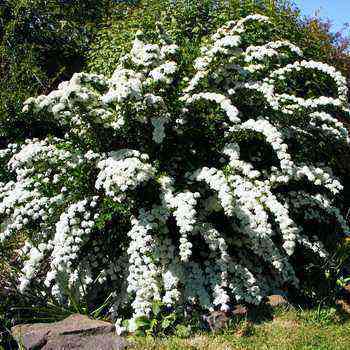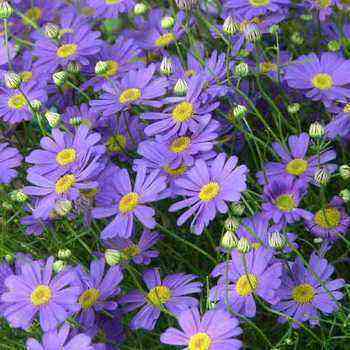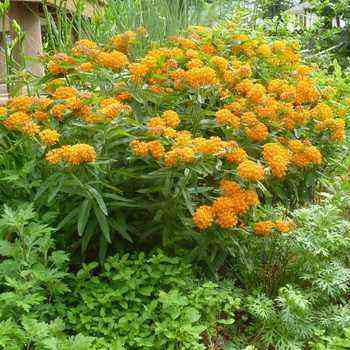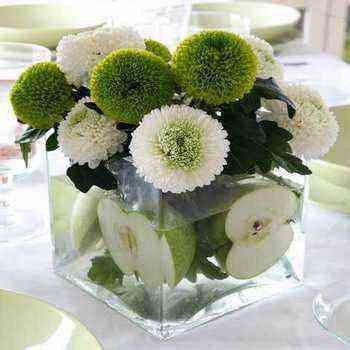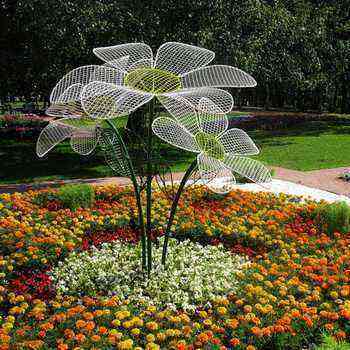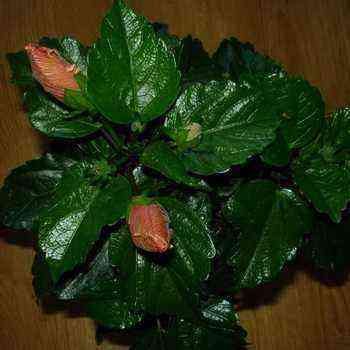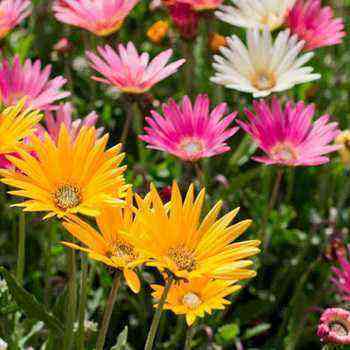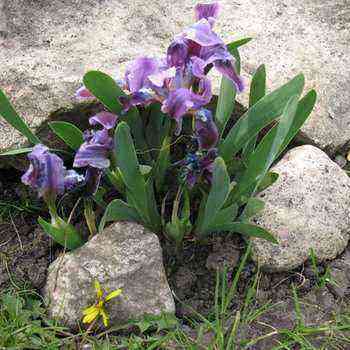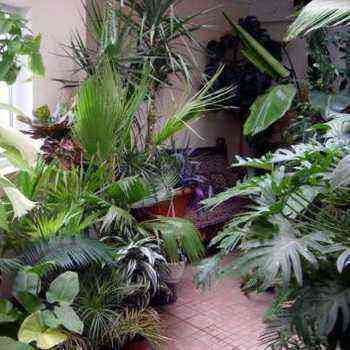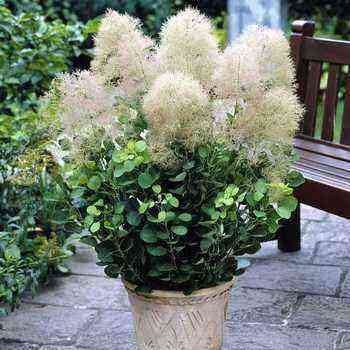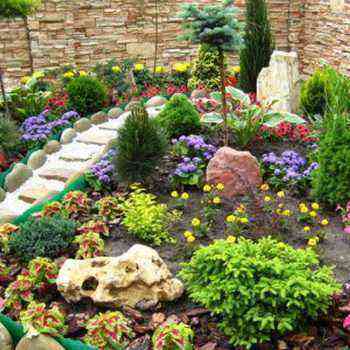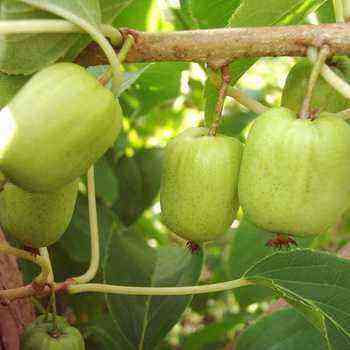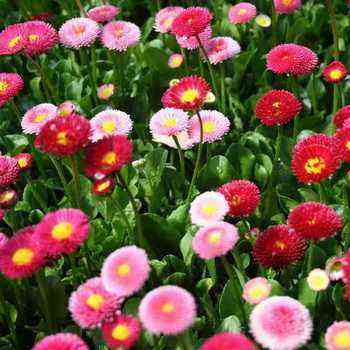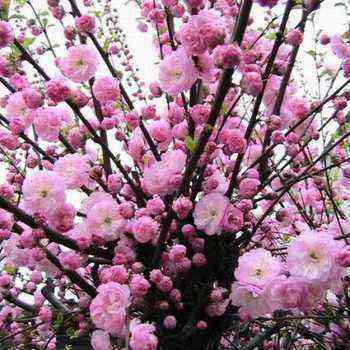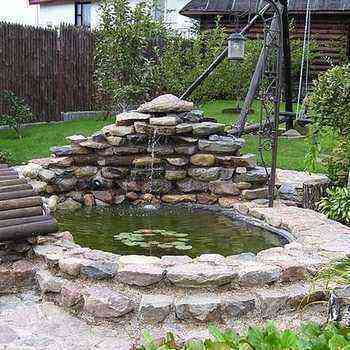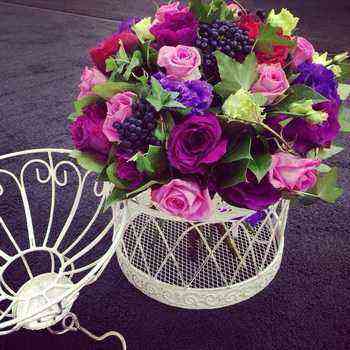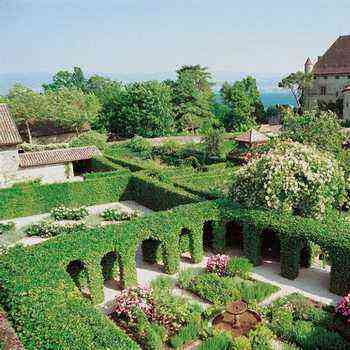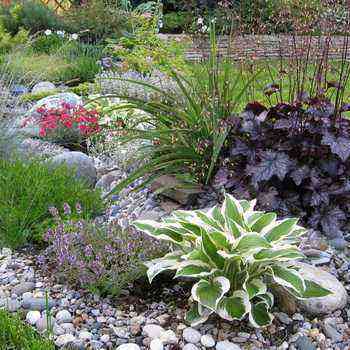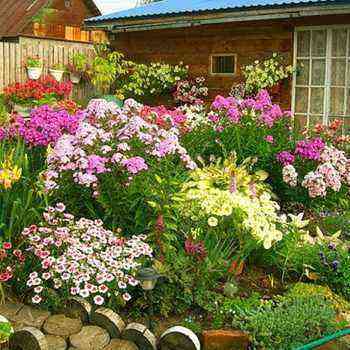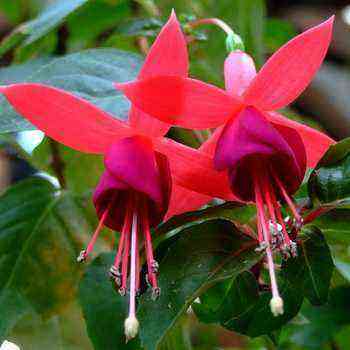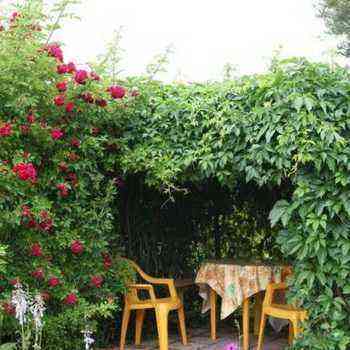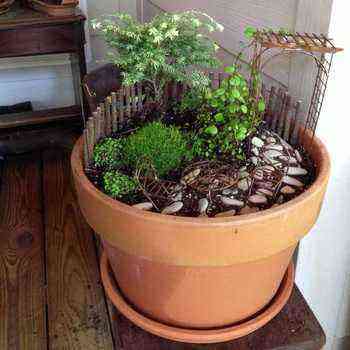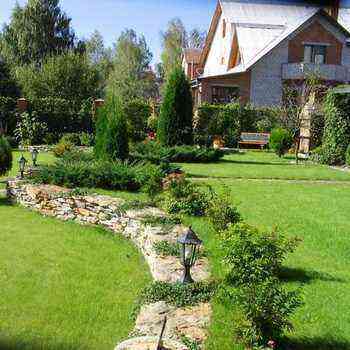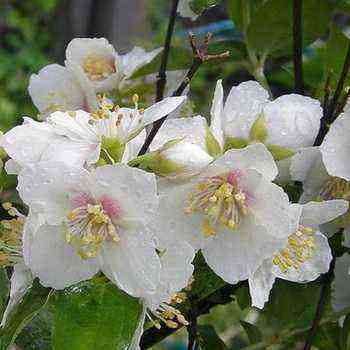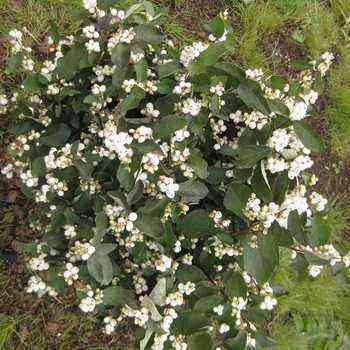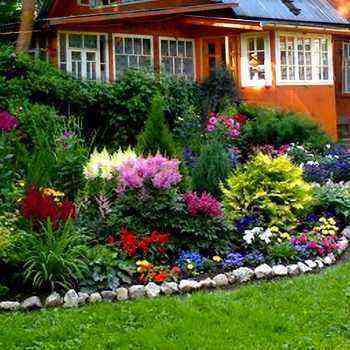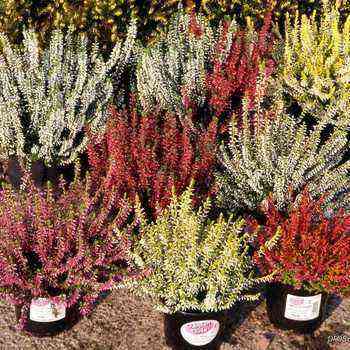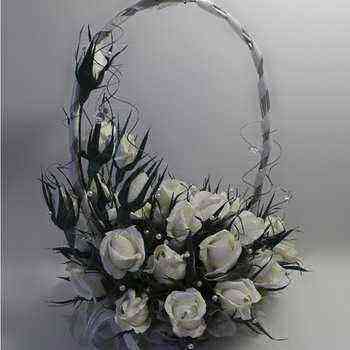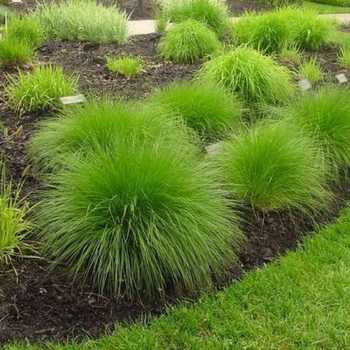 Almost all types of meadow sedges growing in the middle lane are used in ornamental gardening. These plants are ideal for decorating flower gardens, alpine slides, rock gardens, dry streams and garden ponds. Some sedge species are used to strengthen loose slopes and coastal areas.
Almost all types of meadow sedges growing in the middle lane are used in ornamental gardening. These plants are ideal for decorating flower gardens, alpine slides, rock gardens, dry streams and garden ponds. Some sedge species are used to strengthen loose slopes and coastal areas.
general description
Sedges (Sageh) are an extensive genus of perennials from the sedge family (Suregaseae). They have a triangular stem, the leaves are arranged in a spiral, forming 3 rows when viewed from above. On the leaf, in addition to the middle one, two lateral veins are especially well distinguished. Often the sheet is two-fold. The flowers are unisexual, although they are almost always found on the same plant. Male is practically only 3 stamens. The female flower, or pouch, contains a pistil with 2-3 stigmas that protrude from the nose of the pouch.
Male and female flowers are covered with covering scales and collected in spikelets. Spikelets can consist of flowers of the same sex, then the male spikelets are located at the top of the stem, the female ones sit below. Spikelets can be mixed. The arrangement of flowers in mixed spikelets is varied: some are higher, then others, and sometimes in layers.
The sedge fruit is a nut, which is all enclosed in the same bag.
Further you can familiarize yourself with the names, photos and descriptions of the sedge meadow plant of the most popular ornamental species and varieties, as well as learn about the use of this herb in landscape design when landscaping a summer cottage.
Arnell’s sedge
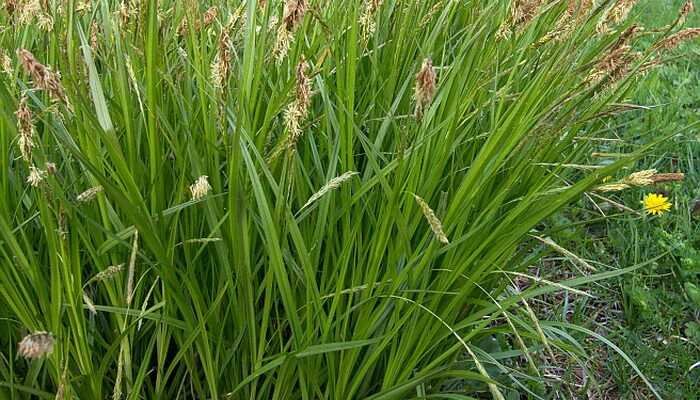
Arnel’s sedge (Sageh arnelii) forms small dense mounds 30-50 cm high.
Leaves are clear green, flat, about 3 mm wide. The stems are almost equal to the leaves. Inflorescences with separate spikelets. Bracts with long plastic, equal or almost equal to the inflorescence. The bottom 2-4 spikelets are pistillate, loose and spaced, 3-5 cm long, droop on long legs when ripe. The upper male spikelets are 1-3. The covering scales of pistillate flowers are equal to sacs, long pointed, with a green midrib. Sacs 5-6 mm long, light green, swollen, glabrous and smooth, wedge-shaped at the base, abruptly narrowed into a thin and long (about 1,5 mm) spout.
Grows in forests and meadows of Siberia.
Suitable for flower beds, slides, dry streams.
Whitish sedge
Whitish sedge (Sageh albula or C. comans var. Stricta) is marketed under the names:
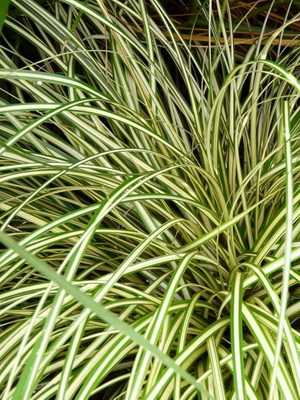
C. ‘Frosted, Curls’

C. comans “Frosted Curls”
It has the shape of a large, fluffy wig, characteristic of New Zealand sedges, up to 30 cm in height. Filiform, flat-convex, tough, shiny, greenish-whitish leaves, curled at the ends. The peduncles are very short at first, then they are aligned with the leaves, the spikelets are 3-6 separate, the upper one is male, the rest are female. Female spikelets are narrow and have the color of leaves. The scales are creamy with thin brown strokes, short and pointed. The pouches are light brown with splayed nose teeth. Snout 3.

From a similar Fr. comans (C. comans) differs in a somewhat protruding form, color of foliage and pale scales.
Requires good drainage, does not tolerate waterlogging. Winters unstably in the Moscow region.
Used for flower gardens in a natural style.
Bergren’s sedge
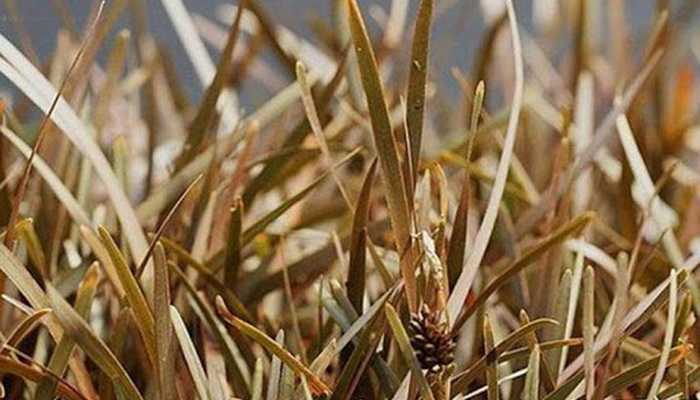
Bergren’s sedge (Sageh berggreni) is a dwarf plant that forms rugs up to 10 cm in height, rarely taller.
Leaves are flat, spreading, with rounded ends, up to 3 mm wide, their color varies from khaki to olive, gray and bronze-purple. Numerous peduncles are shorter than leaves. Spikelets are hidden in the inflorescence leaves, there are 3-4 of them, the upper one is male, the rest are female, rounded, reddish-brown. Pouches with an inconspicuous spout. Snout 2-3. Homeland – the highlands of New Zealand.
In the middle lane it overwinters irregularly, sometimes it resumes by self-seeding. It grows in acidic, moist soil. The color is brighter in the sun.
Used in rock gardens and shallow reservoirs.
Pale sedge

Pale sedge (Carex pallescens) is a dense sod plant, light green, shortly pubescent, up to 60 cm tall.
Leaves up to 4 mm wide, shorter than the stem. Inflorescence of one male and 2-4 female spikelets. Female spikelets on short legs, crowded, oval, completely green. The pouches are elliptical. Rylets 3. Grows in meadows and light forests throughout Russia, in Pale sedge in the Caucasus, in Western Europe.
A neat plant for flower beds.
Bohemian sedge
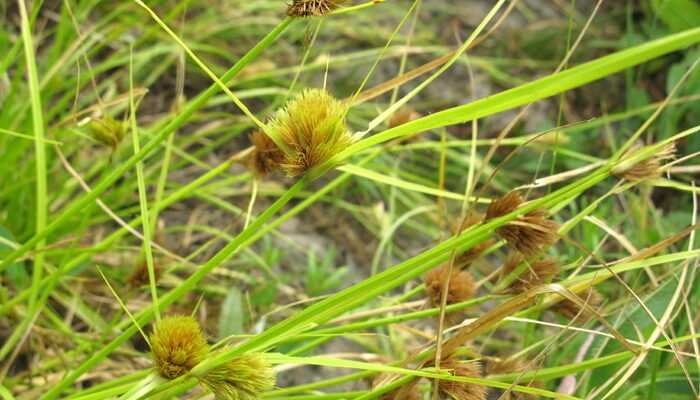
Bohemian sedge (Carex bohemica) is a biennial or juvenile plant, up to 30 cm tall, with dense bright green tufts.
Leaves up to 2,5 mm wide, almost flat, slightly shorter than the stem. The inflorescence is capitate of contiguous spikelets, with several long inflorescences. Spikelets are brownish-green, mixed, with pistillate flowers at the top and staminate at the bottom. Covering scales are narrow and sharp. Sacs 7-8 mm, on legs, narrow, elongated, with a very long nose. Rylets 2. Occasionally found throughout Eurasia Bohemian sedge on the damp sandy shores of reservoirs. A very original plant, but rarely grown.
See what a sedge plant of different species looks like in these photos:
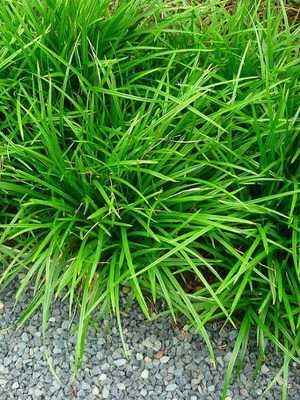

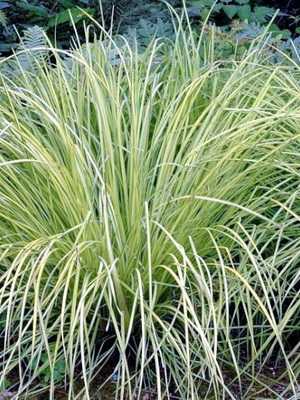
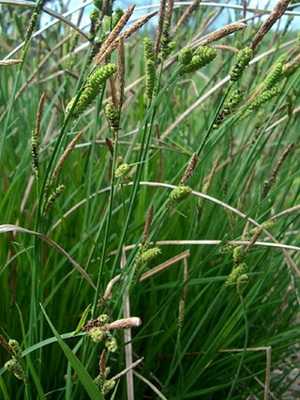
Buhanana’s sedge

Buchanan sedge (Carex buchananii) is marketed under the name Leatherleaf sedge.
Forms a very dense curtain, up to 60 cm high and 100 cm wide, from hard shiny leaves in bronze and rusty tones. Young plants with protruding leaves, with age, take the form of a vase. Leaves 1-1,5 mm wide, folded. The peduncles, like the leaves, are gracefully curved and almost the same length as them. The inflorescence is longer than the inflorescence. Spikelets 5-6, they are brown, spaced. The upper one is male, the rest are female up to 3 cm long, hanging on hair-like legs. Scales with clear spine. Pouches with a thin and long bipartite spout. Rylets 2. It differs from similar species C. albula and C. comans in greater height and 2 stigmas. Like other New Zealand sedges, it grows best in sunny, moist, but well-drained areas. It hibernates unstably in the middle lane, it gets wet, then it freezes. Can leave self-seeding. Often cultivated as an annual.
One of the most popular New Zealand flower beds.
Heather sedge
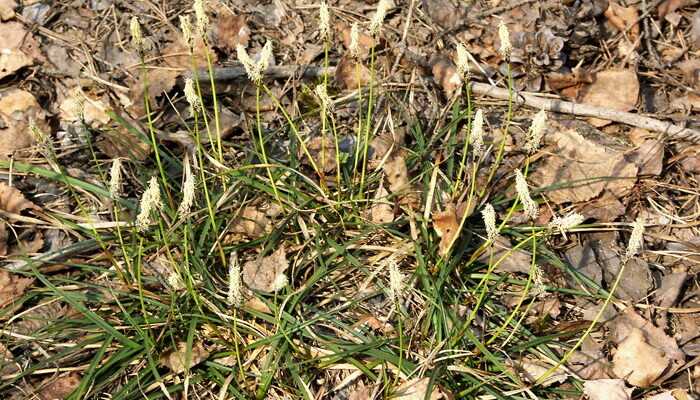
Heather sedge (Carex ericetorum) is a small sod sedge with short creeping rhizomes.
Leaves 2-3 mm wide, grayish-green, partly overwintering, tough. Inflorescences above the leaves, consist of 1-3 sessile oval female spikelets and one long male spikelet. The sacs are oval-ovate, 2-2,5 mm long, pubescent, with a very short nose, covered with dark brown covering scales with fringed edges. Snout 3.
A widespread plant in the forest zone, usually found on sandy soil in pine forests and meadows. Especially noticeable in May when it blooms.
A neat graceful plant for sunny and semi-shady hills, flower beds.
Water sedge
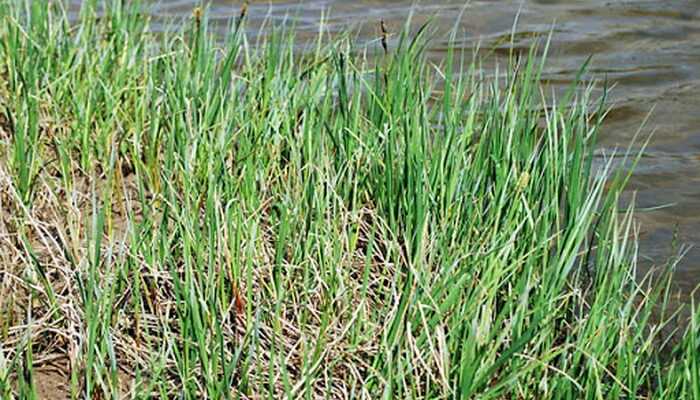
Sedge aquatic (Carex aquatilis) is a grayish-green tough plant up to 100 cm tall, with short rhizomes, spreads in a dense curtain.
The leaves are 3-6 mm wide, the inflorescences are shorter than the leaves, and the inflorescence is longer. There are several male spikelets, female – up to 5. They are sessile, up to 9 cm long. Sacs are smooth, flattened, almost without a spout, stigmas 2. Covering scales are brown with a green center, narrow and obtuse. Grows in swamps and water bodies in the Northern Hemisphere.
Most often they are used to secure the banks of reservoirs.
Bloated sedge

Bloated sedge (Carex physodes) is a grayish-green perennial, up to 30 cm tall, with long rhizomes.
Leaves are filiform, protruding. Stems are thin, bent with a heavy inflorescence. Spikelets 3-7, collected in a dense head. Pouches of rusty color, evenly covered with veins, after ripening they swell with bubbles up to 2 cm long.
Inhabits the sandy steppes and deserts of southern Russia, Central Asia and China.
An original plant for collectors.
Hairy sedge

Hairy sedge (Sageh pilosa) is a plant with long rhizomes and spaced vegetative and flowering shoots.
Overwintering leaves, pure green, up to 1 cm wide. Peduncles up to 40 cm tall with several spikelets, the top of which is male. Female spikelets are spaced apart, sticking out on long legs, rarely flowering. The pouches are swollen, green, with a distinct two-toothed nose. Rylets 3. Common plant in European forests, especially broadleaf.
For parks, naturgardens. In spring, large yellow male spikelets look beautiful against the background of last year’s dark leaves.
Sedge high
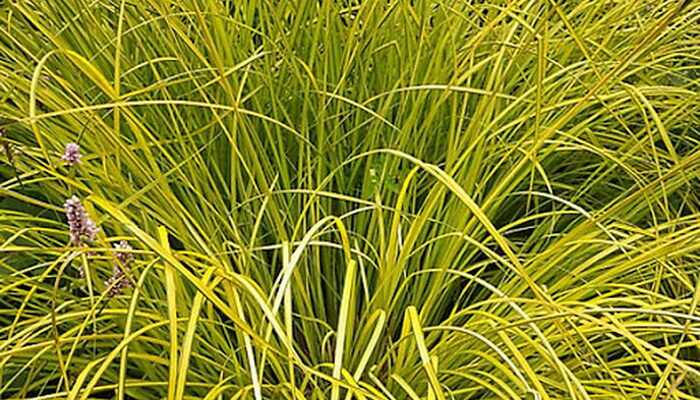
Sedge high (Carex elata or C. Stricta) is a powerful pure green plant about 150 cm tall, forming large hummocks with light brownish-yellow scales at the base.
Leaves are erect, rigid, 3-6 mm wide, shorter than the stem.
There are 1-2 stamen spikelets.
Pistillate – 2-3. Spikelets are even, narrow, sacs are ovoid, smooth, covered with sharp narrow scales. Knight 2.
Distributed in swamps and on the shores of reservoirs throughout Europe and the Caucasus.
For decorating ponds.
Grades:
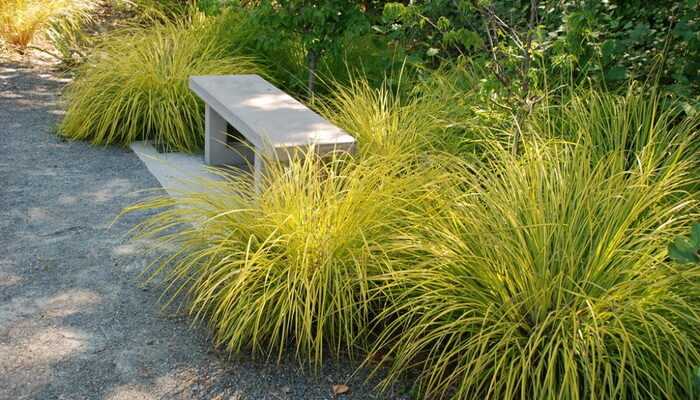
“Aurea” (“Bowles Golden”) – less high. Yellow leaves with irregular light green stripes, become greener in the shade, and straw in the sun with a lack of water.
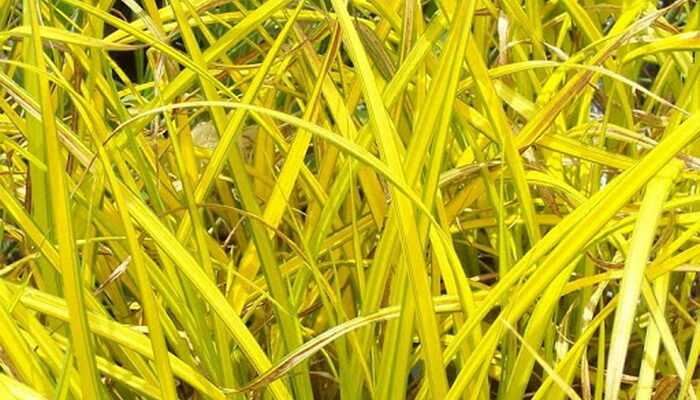
Knightshayes is pure yellow.
Clove sedge, or spring
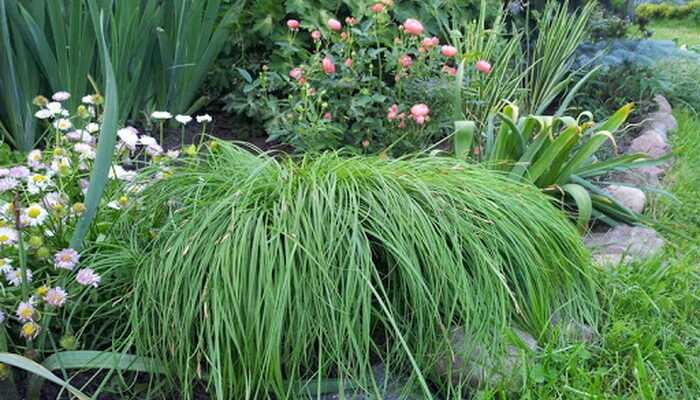
Clove sedge, or spring sedge (Carex caryophyllea) on sale may be confused with the closely related Western European species about. shadow (C. umbrosa). Forms a loose, spreading curtain up to 30 cm in height, with yellowish-gray scales at the base.
Leaves 1,5-4 mm wide, green, rather soft and spreading, shorter than peduncles. Spikelets are crowded, male one, female – 2-3, oval. The sacs are pear-shaped, pubescent, with veins and a short spout. The scales are brown with a green vein, equal to the sacs. Rylets 3. Occurs on dry glades and forest edges in central Russia, the Caucasus, and Western Europe.
Small neat plant for flower gardens and rock gardens.
Grades:

“The Beaties” – shaggy, with long, curled leaves at the ends. May get wet in winter.
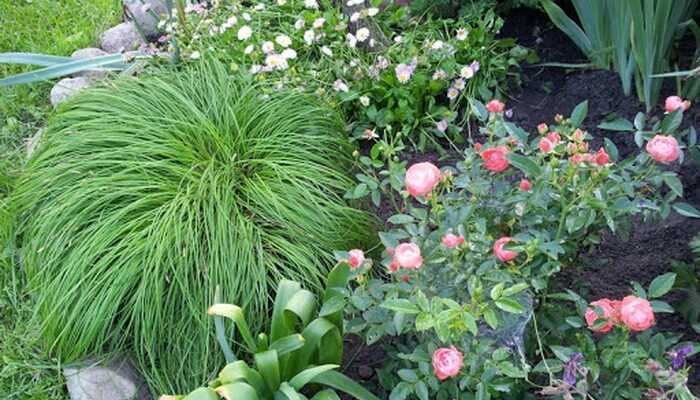
“Beatlemania” is a similar variety, but leaves with a narrow whitish border.
Smooth-nosed sedge
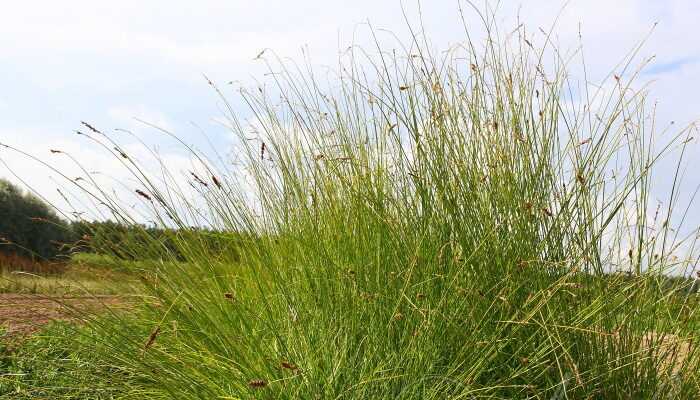
Smooth-nosed sedge (Carex leiorhyncha) is a large dense sod sedge up to 50 cm tall.
Leaves are grayish green, flat, 3-4 mm wide, slightly shorter than the stems. Inflorescences of numerous mixed spikelets. Covering leaves significantly exceed spikelets. The covering scales of the sacs are short, with brown shading and a green back. Sacs are flat-convex, smooth, narrowed into a long, two-toothed spout.
Grows in meadows and the outskirts of bogs in Eastern Siberia and the Far East.
A powerful, recognizable species, suitable for flower gardens, goes well with shrubs.
Blue sedge
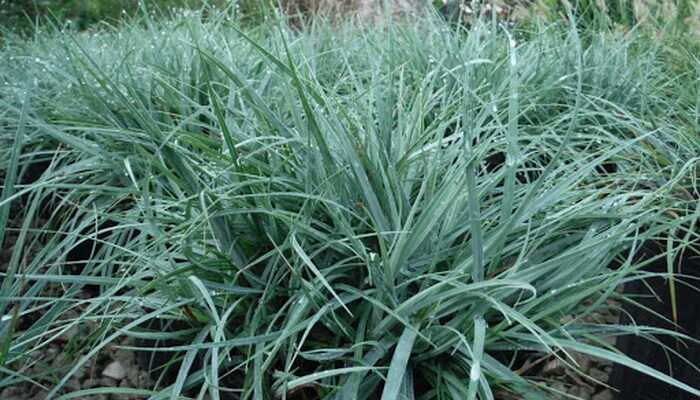
Blue sedge (Carex flacca or C. glauca) spreads out with rhizomes, forming dense rugs of entangled leaves.
Leaves up to 3 mm wide, similar to the leaves of a pinnate carnation, usually green above and bluish below. Peduncles are longer than leaves, up to 15-40 cm tall. Male spikelet is one, female – 2-3. Female spikelets up to 4 cm long, hanging, reddish-brown. The pouches are swollen, almost without a nose. Snout 3.
Grows in damp meadows, limestones, sand dunes and seaside swamps in Western Europe, introduced to North America.
Drought-resistant, suitable for all types of soil.
Good groundcover for sun and partial shade.
Grades:
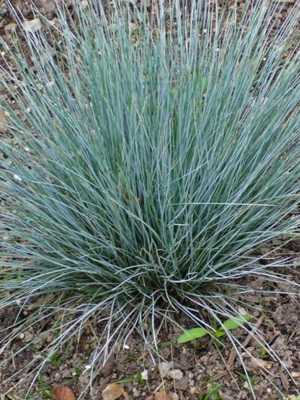
“Bias”

“Blue Zinger” – with a distinct blue tint.
Mountain sedge
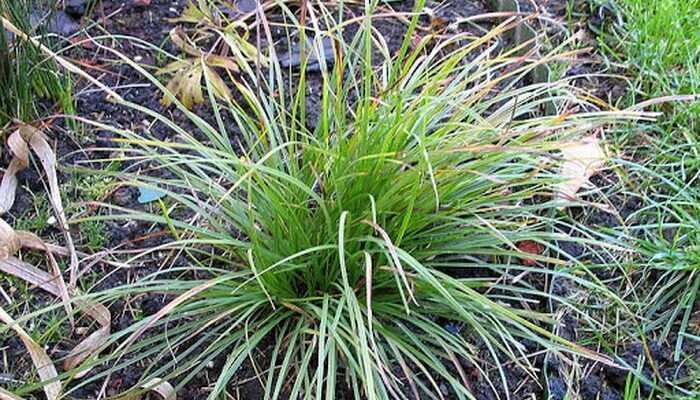
Mountain sedge (Carex montana) is a dense sod plant, up to 30 cm tall, with abundant remnants of dead leaves at the base.
Leaves are bright green, flat, up to 2 mm wide, soft, shorter than the stem. Spikelets are crowded, one male, two female, they are dense, rounded. Sacs obovate, light green, pubescent. Snout 3. With colored scales, dark brown, rounded with a sharp point. It is found in dry light forests, mainly in the black earth zone of Russia and in Western Europe.
For flower gardens and rock gardens.
Grades:
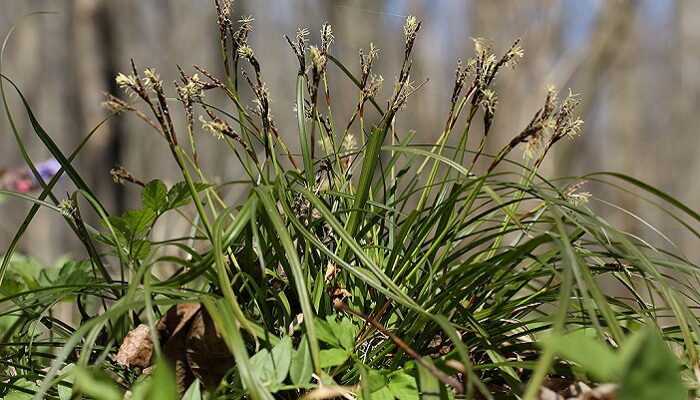
“Raureif” – dense, compact, leaves with a narrow white border, which makes the whole plant appear bluish.
Gray sedge
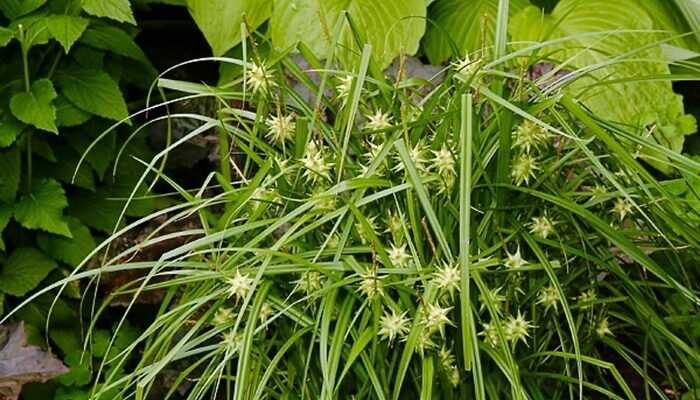
Gray sedge (Carex grayi) is a plant with dense turf. Stems up to 100 cm tall, leafy.
Basal leaves are tin, yellowish-green, protruding, up to 1 cm wide. Inflorescences of 1-2 apical male ears and several sedentary female ears, similar to green hedgehogs, are clearly visible. Pouches up to 1,5 cm long, with distinct veins, sticking out in different directions. Originally from the forests of the east coast of North America.
It grows well in damp places and in ordinary flower beds, it is quite stable in the middle lane.
Sod sedge

Sod sedge (Cageh cespitosa) forms strong, tall tussocks with reddish scales at the base of the shoots.
Pure green plant up to 60 cm tall. Leaves 2-3 mm wide, slightly shorter than the peduncle. There is one male spikelet, several female ones, 1-3 cm long. Covering scales are short, dark. Sacs smooth, convex, stigmas 2.
It grows on shores and marshes throughout the country, except for the Far East, and in Western Europe.
Simple and effective plant for flower gardens and borders.
Long-spike sedge

Long-spike sedge (Carex dolichostachya) is a plant with short rhizomes, forming loose tussocks with reddish scales at the base.
Leaves are leathery or rather soft, characteristically rough, 3-8 mm wide. Peduncles up to 50 cm tall, with 3-5 spaced loose, multi-flowered spikelets up to 3 cm long. The scales are brown, in male spikelets, dull or gradually sharpened. Sacs are triangular, shortly downy, with thin veins and a short nose. Rylets 3. A similar species about. Hoshien (C. hachijoen sis) is distinguished by light brown scales at the base, 6-7 dense, smooth leaves and oval sacs with clear veins.
Plant of the forests of Japan.
Looks great in flower beds.
Grades:
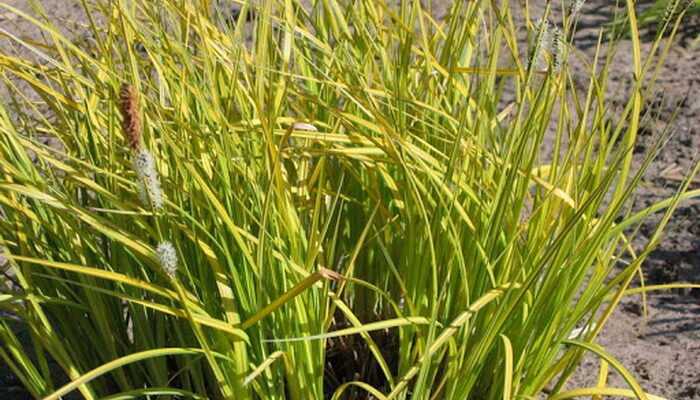
“Kaga Nishiki” (“Golden Fountains”) – the leaves have yellowish edges.
Davell’s sedge
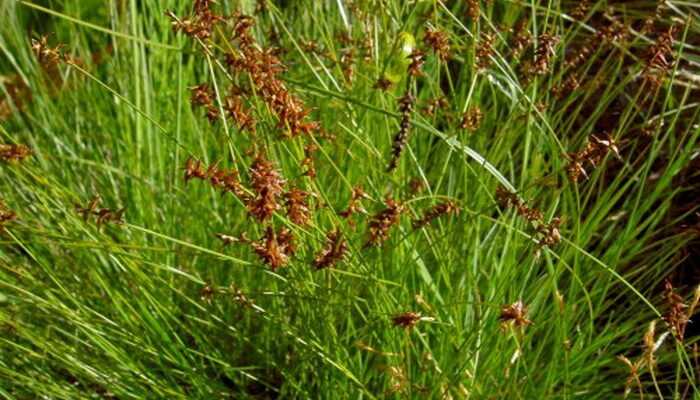
Davell’s sedge (Carex davalliana) is a pure green plant, up to 40 cm tall, forming a very dense, lush turf.
Bristle leaves and numerous, longer stems point in different directions. It is dioecious. Male spikelets are single, narrow. Females are also solitary, up to 1,5 cm long, with protruding, flattened, nasal sacs of dark, almost black color. Knight 2.
Grows in swamps and marshy meadows, along river banks, on a limestone substrate in Western Europe.
A very neat plant for sunny watered flower gardens and swamp gardens.
Yellow sedge
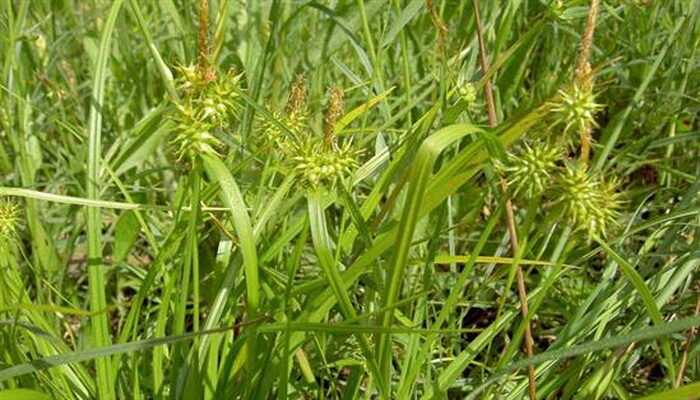
Yellow sedge (Carex flava) – light, yellowish-green sedge with protruding leaves up to 5 mm wide.
Forms a small dense turf up to 40 cm tall. Stems are vertical, longer than leaves. Inflorescences sticking out in different directions.
One male spikelet, female – rounded, crowded, yellowish, after ripening with a blush. The pouches are large, with long noses, spread out. Snout 3.
Grows in damp meadows mainly in Europe.
Well-recognizable, attractive plant. Suitable for flower gardens.
Pointed sedge
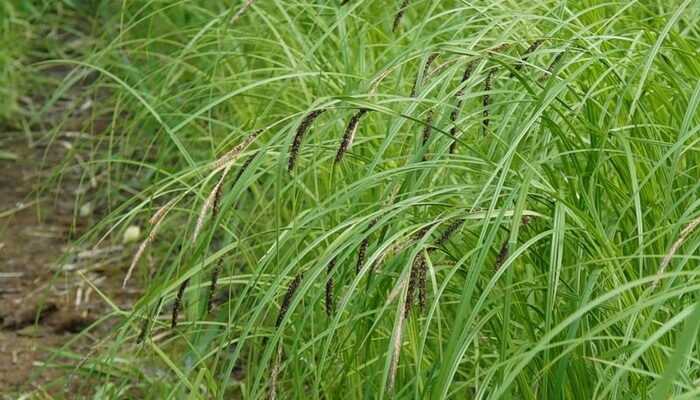
Pointed sedge (Carex acutiformis) is a bluish plant up to 100 cm tall, with long thick rhizomes.
The scales are red-brown at the base. Leaves about 10 mm wide slightly exceed the inflorescence. There are several stamen and pistillate spikelets. Pistillate – up to 5 cm long, almost sessile Sedge pointed and protruding. Scales sharp, narrow, equal to sacs, brown. The pouches are flat with a short spout. Snout 3.
In Russia, it is found everywhere in damp meadows and sedge bogs, as well as in Western Europe, Central and Asia Minor.
It is used to anchor the banks of natural reservoirs.
Hare sedge
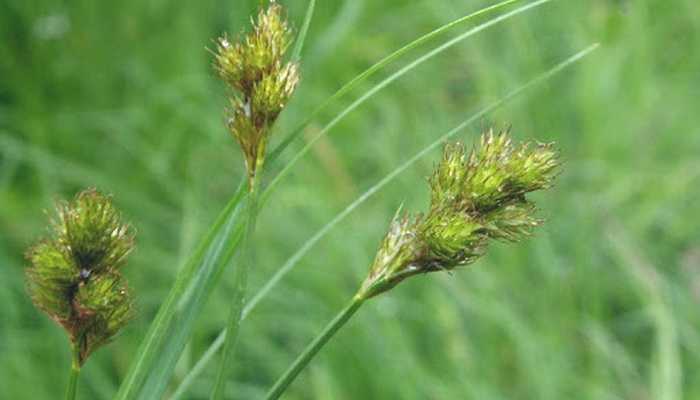
The hare sedge (Sageh leporina) is a dense turf plant. Stems up to 60 cm tall, leaves are noticeably shorter.
Leaves are flat or grooved, pure green, up to 3 mm wide. Inflorescence of 4-6 contiguous ovoid mixed spikelets of brownish-marsh color, up to 1 cm long. Covering scales are sharp, narrow. The pouches are 5 mm long, flattened and narrowed at the spout. Knight 2.
A common meadow plant, also found in light forests, on roadsides throughout the Northern Hemisphere.
Unpretentious, but looks good in flower beds, in natural gardens.
Sedge comance
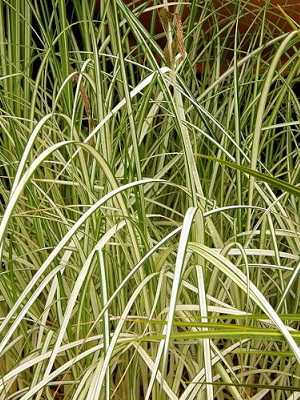
Carex comans on sale are sometimes confused with Fr. Buchanan and Fr. whitish.
The dense curtain is in the form of a fluffy wig up to 90 cm wide and 30 cm high. Leaves are filiform, up to 1,5 mm wide, sometimes with twisted ends. Peduncles are shorter than leaves, with 4-8 spikelets, the upper of which is male. Female spikelets are light brown, linear, up to 2,5 cm long, spaced apart, the lower ones are drooping on the thinnest legs. Scales at the ends are usually bipartite with a short spine. The pouches are extended into a bipartite spout. Snout 3.
For sunny and semi-shady places with good drainage. Weakly hardy in the middle lane.
New Zealand sedge for flower beds and borders.
Grades:

“Dancing Flame”, “Bronze Perfection” leaves in different shades of bronze
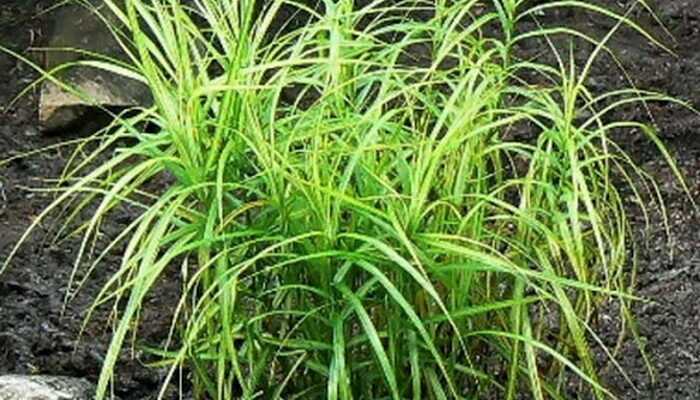
Greyassina has brownish-boggy
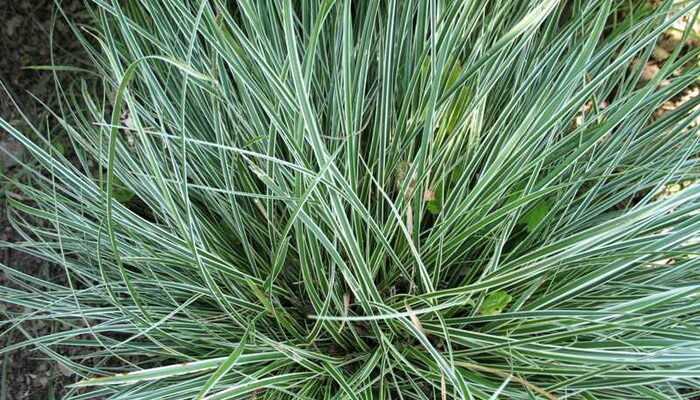
Milk Chocolate has light brown
Conical sedge
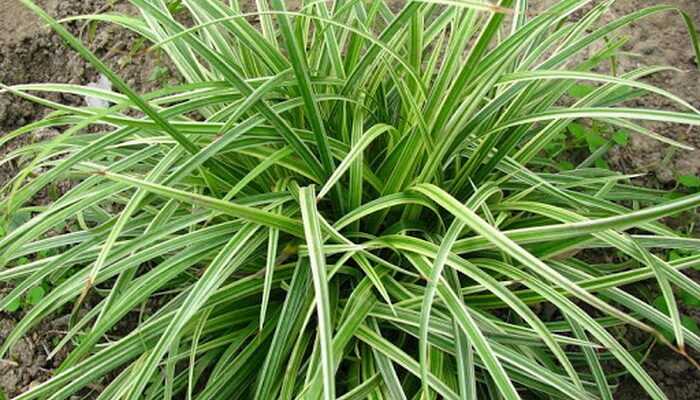
Conical sedge (Carex conica) is a dense sod plant forming a wide hummock up to 30 cm tall, with brown fibers at the base.
The leaves are dark, flat, 2-4 mm wide, arcuate, spreading, rough. Saber-shaped peduncles with 3-5 erect, dense, spaced spikelets up to 2,5 cm long. The scales are dark brown. The pouches are oval with sparse hairs and a short, curved nose. Snout 3.
Homeland – Japan. Weakly hardy in the middle lane.
For flower gardens and rock gardens.
Grades:
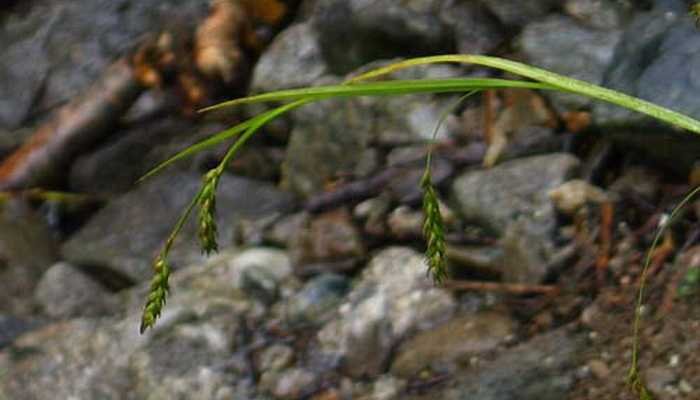
“Snowline” (“Marginata”, “Variegata”) – has dark leaves with a pure white border, grows slowly
Forest sedge
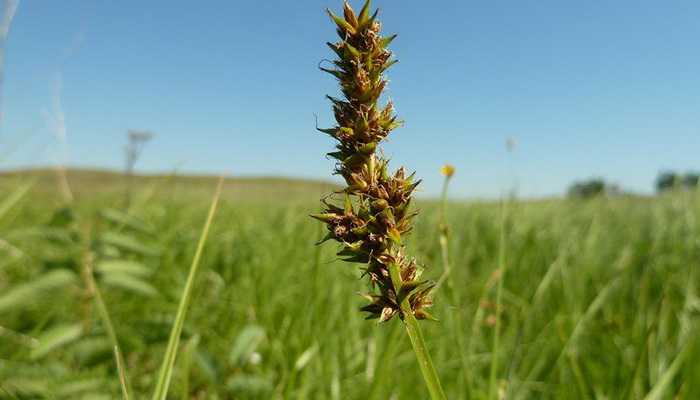
Forest sedge (Carex sylvatica) is a densely turfy, pure green plant up to 80 cm tall.
Leaves 8 mm wide, dark green, arcuate, overwintering. Peduncles above the leaves, spreading. They carry one male spikelet and several widely spaced, loose and narrow female spikelets, hanging on thin legs. Pouches with a long drawn spout. Columns 3.
Often found in shady forests and parks, mostly European. Very shade-tolerant, forms a continuous emerald green cover on the soil.
For parks, gardens in a natural style.
Fox sedge
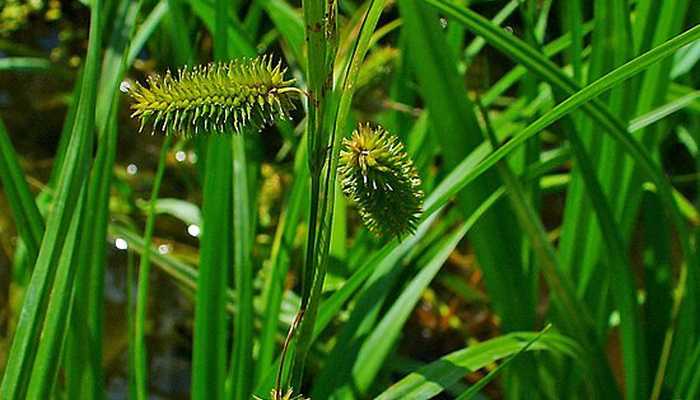
Fox sedge (Carex vulpina) is a dense sod, pure green plant up to 100 cm tall.
Leaves are flat, with a clear keel, up to 1 cm wide. Peduncles are longer than leaves, strong, triangular, with narrow wings. Inflorescences are dense, up to 19 cm long, brownish, collected from mixed spikelets. The scales are brownish, with an awn, smaller than the sacs. The sacs are large, with a drawn-out spout and ribbed veins. Rylets 2. Grows in swamps and ditches throughout Europe and southern Siberia.
A very effective plant for the design of reservoirs.
False sedge
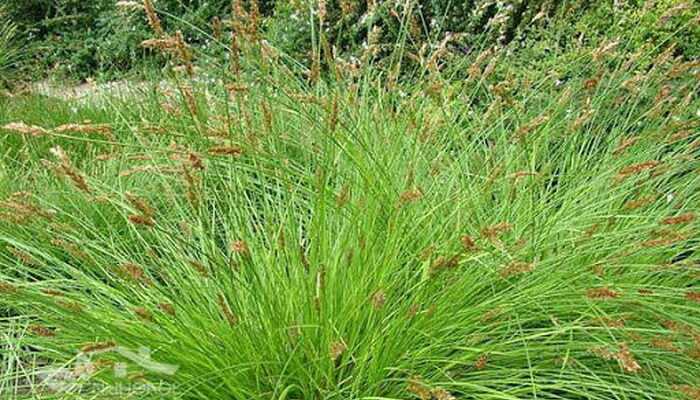
Pseudo-sycamore sedge (Carex pseudocyperus) is a light green dense sod plant up to 100 cm tall.
Leaves are harsh, flat, 5-10 mm wide, similar long leaves accompany the lower spikelets. There is only one male spikelet. Female spikelets are up to 5 cm long, thick, very close together and hang in a bunch on long legs, young ones are green, mature ones turn yellow. The pouches are strongly protruding, their noses are long, with sharp teeth. Snout 3.
It grows on damp shores and swamps throughout the Northern Hemisphere.
Spectacular, easily recognizable plant for ponds and swamp gardens.
Panicle sedge

Panicled sedge (Carex paniculata) – a plant with short rhizomes, forms large bumps.
Stems up to 100 cm tall. Leaves are pure green, flat, up to 5 mm wide. Light brown paniculate inflorescences up to 19 cm long are hidden among the leaves. Spikelets are mixed. Covering scales are sharp, rusty in color, with wide light edges.
Pouches with a long, two-toothed spout. Rylets 2. Inhabitant of European swamps and damp meadows.
Plant for reservoirs.
Grades:
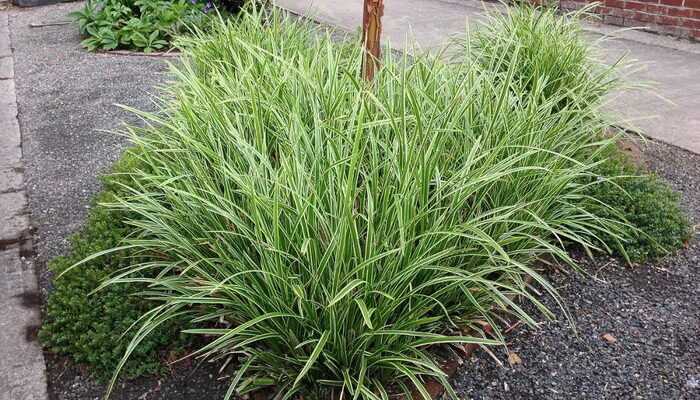
“Monet” – a selected clone, brought by the gardener A. Marchenko from the garden of Claude Monet (France)
Morrow’s sedge
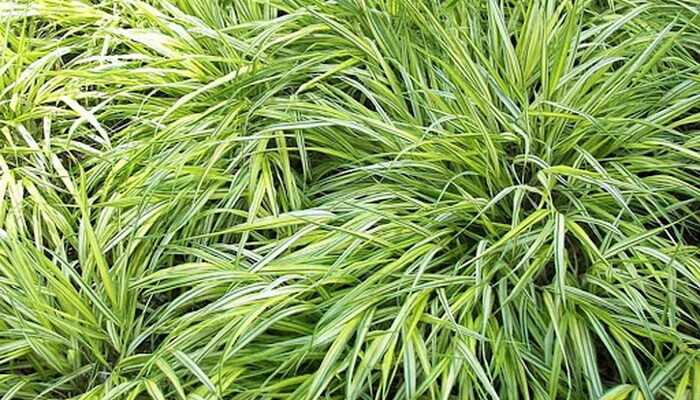
Morrow sedge (Carex morrowii) forms separate dense tussocks.
This plant is 30 cm high and 60 cm wide, with dark brown scales at the base, connected by short rhizomes. Hard, shiny, arcuate leaf, dark green, 5-10 mm wide, with rough edges, more or less preserved in winter. Peduncles with 4-6 spaced spikelets. The scales of male spikelets are brownish with a drawn-out pointed tip. The pouches are glabrous, with a noticeable two-toothed and crooked spout. Snout 3.
Grows in the low-mountain forests of Japan.
One of the most popular sedge species in horticulture. It can grow in ordinary flower beds, both sunny and shaded.
Grades: varieties of this species can include a variety of striped forms of other Japanese sedges of a similar habit and simply of unknown origin.
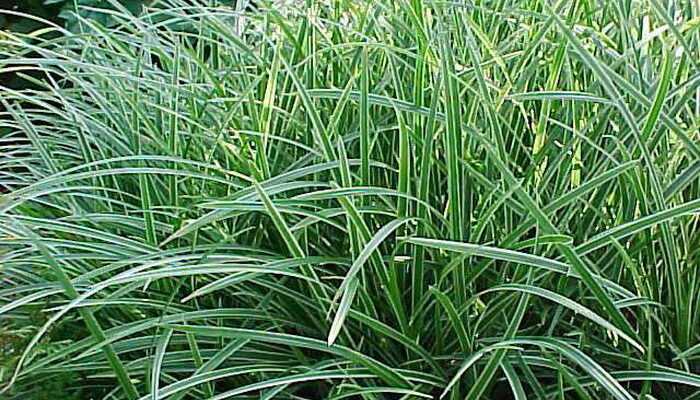
“Aureovariegata” (“Gilt”, “Fisher’s Form”, “Gold Band”) -sheet wide, more than 1 cm, with a white (cream) border. “Ice Dance” is a very popular, fast growing variety with a dark center and crisp creamy white edges (doubtful whether it belongs to this species)
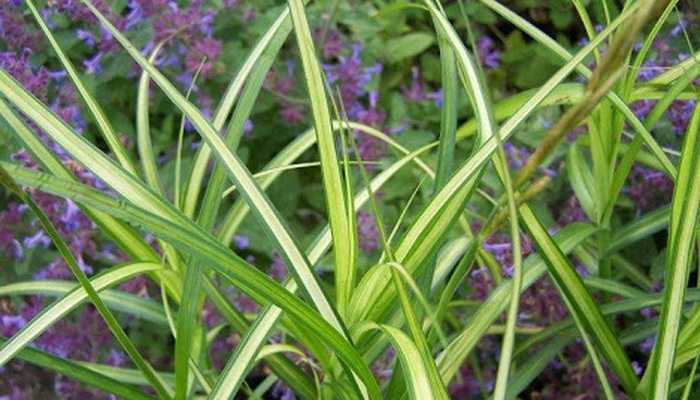
Mosten is a Dutch variety with yellowish-green foliage.
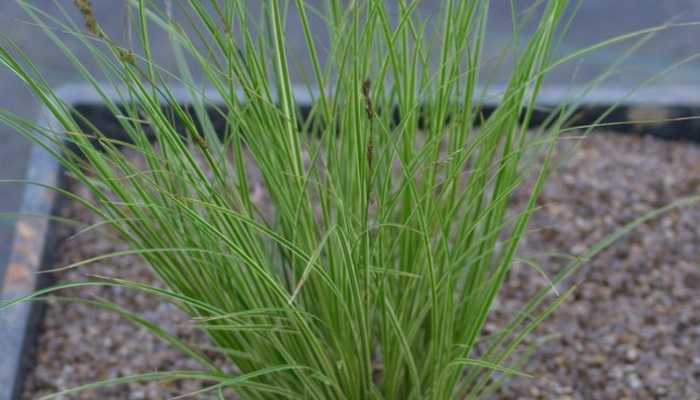
Silk Tassel – with a white line in the center of the sheet.
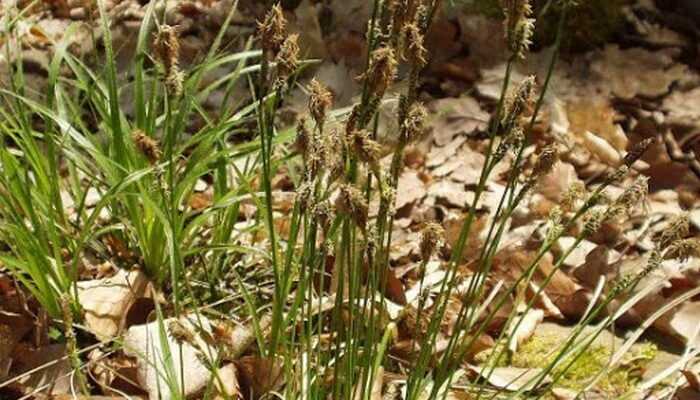
“Silver Scepter” is a hybrid that can only conditionally be attributed to this species. Has a leaf about 6 mm wide with a well-defined white edge, grows slowly.

The frequently suggested variety “Variegata” is the collective name for a number of clones with a white border on the leaf that can vary in width.
Muskingumenskaya sedge
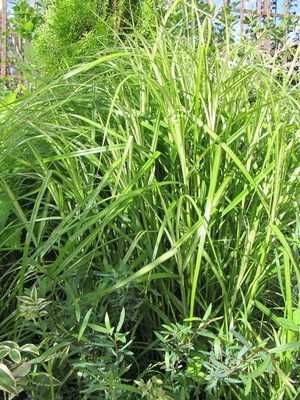
Muskingumen sedge, or palm Carex muskingumensis) spreads out, forming a dense bright green curtain.
Stems up to 100 cm tall, evenly leafy. The leaves are grooved, dense, up to 5 mm wide, spread out to the sides, with hanging ends. Inflorescences at the tops of the shoots, collected from mixed, oval, dense, light brown spikelets. Pouches flattened with winged edges. Knight 2.
Native to North America, where it grows in damp grasslands and forests.
For flower beds. Dislikes drought.
Grades:

Ice Fountain – Leaves with a wide creamy white center.
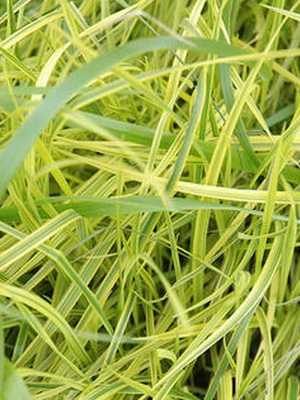
“Little Midge” is a compact variety up to 30 cm tall.

“Oehme” – a leaf with a yellow border
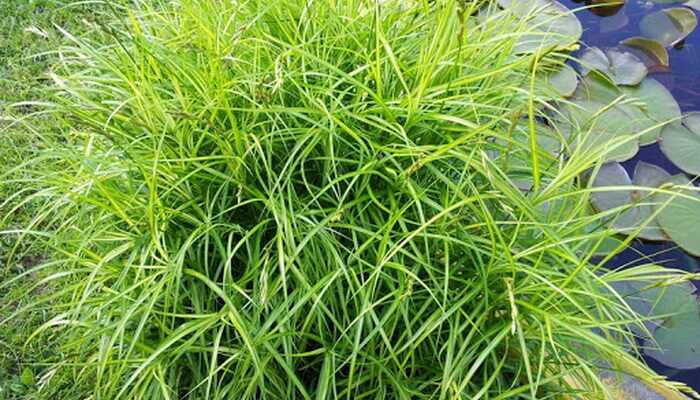
especially bright in spring. “Silberstreif” – sheet with white border

“Wachtposten” – select, tall and bright clone
Sedge low
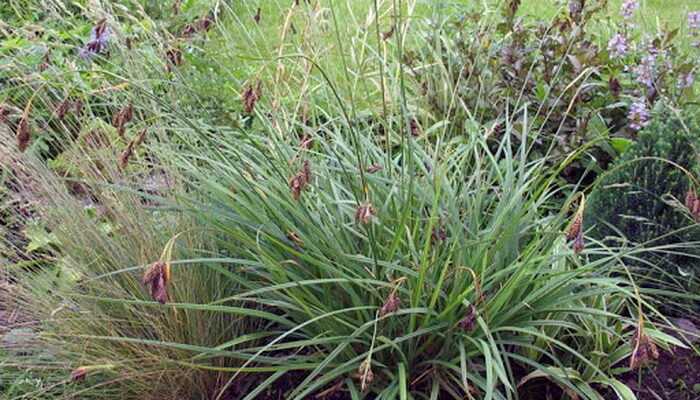
Low sedge (Carex humilis) – dense sod, with red-brown scales at the base.
Leaves are grayish-green, outstretched, up to 1,5 mm wide. Peduncles are shorter than leaves, up to 10 cm tall, with several spikelets spaced along their entire length. The upper spikelet is male, the rest are female, loose, with 2-4 flowers. The scales are large, reddish. The sacs are small, up to 2,5 mm long, pubescent, with a short spout. Snout 3.
Plant of the steppe zone, also found in the south of Western Siberia and the Caucasus.
For rock gardens. Differs in early bright flowering.
Pubescent sedge

Pubescent sedge (Carex hirta) is a light green, pubescent plant up to 80 cm tall, with long rhizomes.
The leaves are curved in an arc, up to 7 mm wide, rigid. Separate inflorescences. Female spikelets are light, greenish, well-spaced and stick out on short stalks, accompanied by long adherent leaves. The covering scales are spinous. Pouches pubescent, drawn into a two-toothed spout. Knight 2.
It is found in Europe along embankments, edges, often on the sand.
For natural gardens, parks. Secures loose slopes.
Osimenskaya sedge
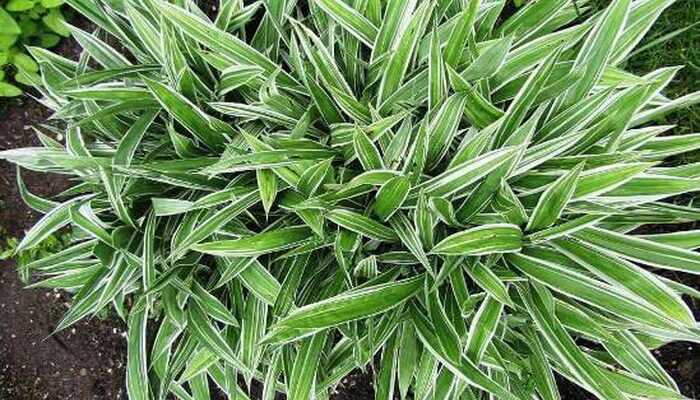
Osimenskaya sedge (Carex oshimensis) is a dense bunchy plant, one of the Japanese species, which is difficult to distinguish from a number of similar ones.
In particular, unlike about. Morrova has narrower leaves, 3-6 mm wide. A characteristic feature: a fluffy pouch with a short, straight nose. Inhabits dry forests and rocks of Japan.
For flower gardens, rock gardens.
Grades:

“Everest” – the leaves are narrow, hard, dark with clear white edges.

“Evergold” (“Everbrite”, “Old Gold”) is a very popular powerful variety, 25 X 40 cm, leaves with pulled and curved ends.
The shade of the creamy white center of the leaf changes to an oily yellow in older leaves and contrasts well with the dark edges. It may also be marketed under the names C. hachijoensis “Evergold” and C. ornithopoda “Evergold”.
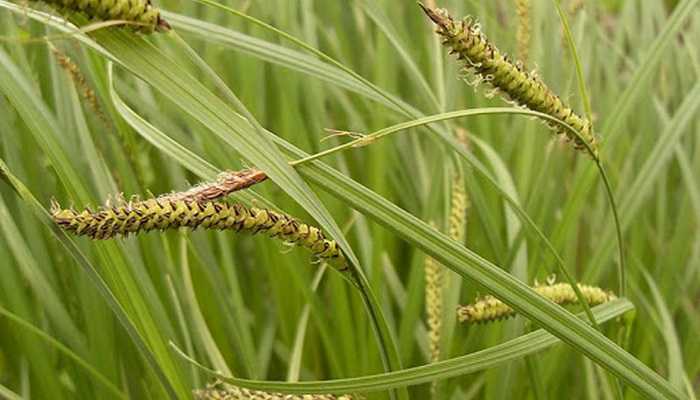
Gold Strike is reminiscent of Evergold, but rather yellow-leaved with narrow green edges.
Spicy sedge

Acute sedge (Carex acuta) is a plant up to 120 cm tall, dark green, with elongated rhizomes.
Stem and leaves of equal length, with rough cutting edges. Leaves are 3-6 mm wide, the lower inflorescence is longer than the inflorescence. There are several male spikelets, female – up to 5. Mature spikelets up to 7 cm long, drooping somewhat. The scales are sharp, dark, with a narrow light stripe, longer than the sacs. Sacs with noticeable veins, convex, with a short spout. Knight 2.
Grows in large clusters throughout Europe, in the south of Western Siberia in damp places.
Used to secure the banks of reservoirs.
Finger sedge
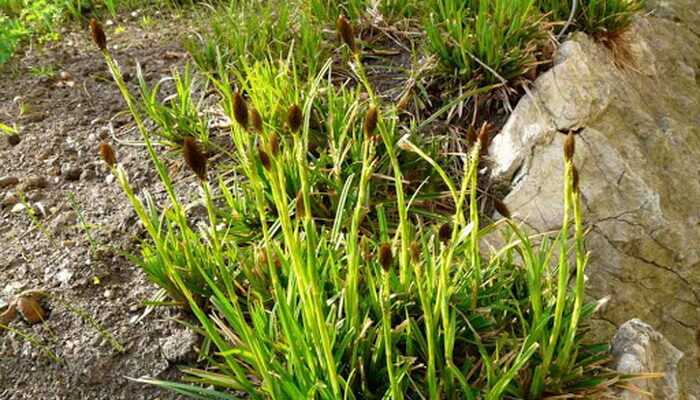
Finger sedge (Carex digitata) is an evergreen dark plant up to 30 cm tall, with red-purple scales at the base.
In the spring it forms small neat tufts with numerous flowering shoots, new leaves grow towards the end of flowering. Male spikelet 1, short; female several. They are elongated, with sparsely spaced flowers and are drawn together at the end of the peduncle, so that in general the inflorescence looks like a finger. Sacs are triangular, pubescent. Snout 3. Scales brownish, rounded.
European look. Often found in shady forests on loose soil.
A very neat and beautiful plant for shade flower beds.
Parva sedge
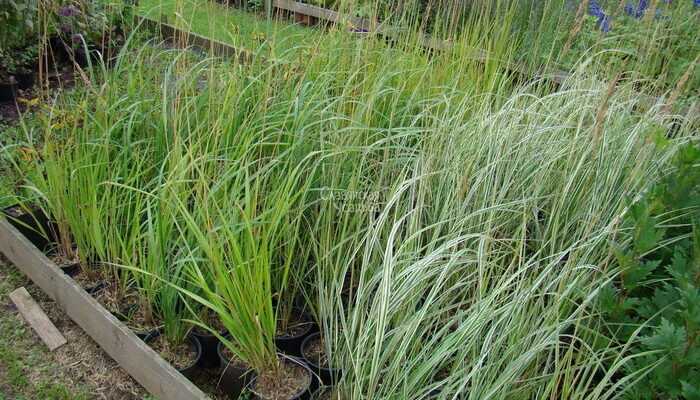
Parva sedge, or short-necked (Carex brevicollis) forms large, dense, pure green hummocks up to 50 cm tall.
The leaves are evergreen, hanging arched. Blooms until the leaves grow back. In the inflorescence 1 male spikelet, 2 female, brown, oval, protruding. The sacs are ovoid, with a short, two-toothed spout. Rylets 3. Plant of deciduous forests of western Europe.
Suitable for flower beds and borders, both sunny and shaded.
For parks. It is beautiful in spring flowering, leaves before winter with green leaves.
Ash sedge

Ash sedge (Sageh canescens) is a dense sod plant up to 50 cm tall.
Leaves 1,5-3 mm wide, grayish, light, almost equal to peduncles. Inflorescence of 4-10 spaced, small, rounded spikelets, pale green. Spikelets are mixed: male flowers sit in their lower part, female flowers in the upper part.
The pouches are oval, convex, with a short spout. Knight 2.
Grows in swamps and damp meadows. Distributed in Russia, in Northern and Central Europe, in the mountains of Central Asia.
Perfect for swamp gardens, ponds.

A similar view is about. brownish (C. brunnescens) – differs in light green leaves and brownish spikelets. Occurs in damp forests, clearings.
Sedge petri
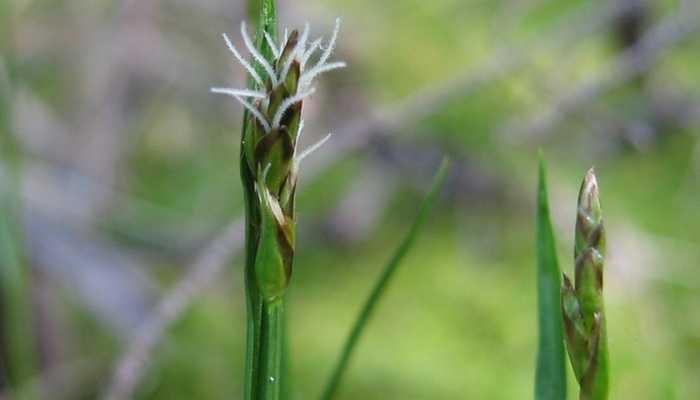
Petri sedge (Carex petriei) is a New Zealand plant. Dense wine-wine, reddish or dark wine-red sedge in the form of a wig up to 25 (35) cm in height.
Leaves are raised, up to 2 mm wide, coiled and with curled ends. The base of the leaves is 3 times wider than the plate. Peduncles up to 35 cm tall, rounded or flattened, slightly shorter than the leaves. Spikelets 4-6, somewhat close, dark brown, upper male, the rest female up to 3 cm long, sticking out on rigid legs. The scales are sharp or even spinous. Sacs narrowly oval, almost black, with a very short spout. Snout 3.
Prefers damp and sunny habitats. More resistant to drought than waterlogging.
For flower beds. Can be cultivated as an annual.
Whip-forming sedge
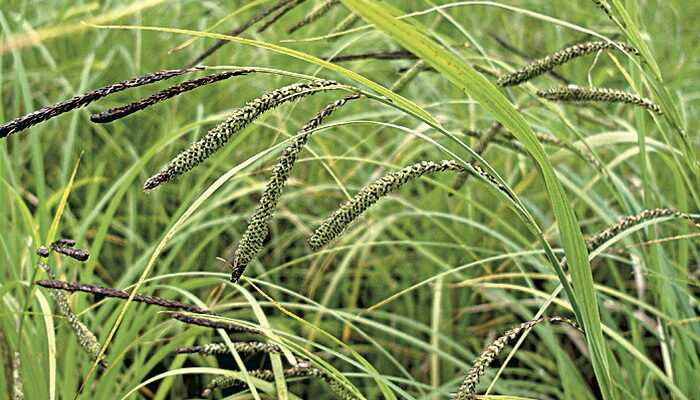
White sedge (Carex flagellifera) – enlarged copy of Fr. comans (C. comans): the same turf, similar to wigs of green, yellowish-green, reddish-green.
Leaves are shiny, grooved, up to 50 cm long, 1,5-2,5 mm wide, spread out to the sides, with drawn sharp ends. Peduncles are short during flowering; during fruiting they stretch out and lie down. Spikelets 4-8, terminal male – crowded, the rest of the female – spaced, almost protruding, up to 3 cm long. The scales are obtuse, but with a short awn, with ciliate margins, leathery, red-brown. The pouches are brown with a short, two-toothed spout. Knight 2. From a similar species – about. testicular – differs in the presence of a green color in some forms, darker and denser scales without shading, characteristic of about. testicular. A New Zealand plant that prefers well-drained areas among shrubs and light forests. Less common in damp and shady places.
For flower beds, containers. Looks good when the inflorescences hang from the retaining wall.
Grades:
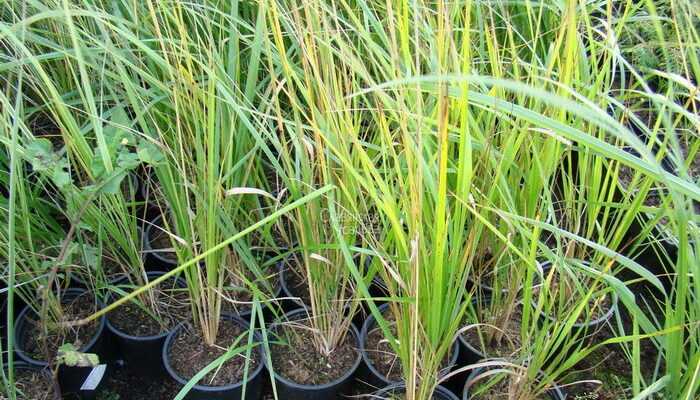
“Toffee Twist” – in essence, the commercial name of this species, a reddish-bronze with green large form, which is most widespread in culture.
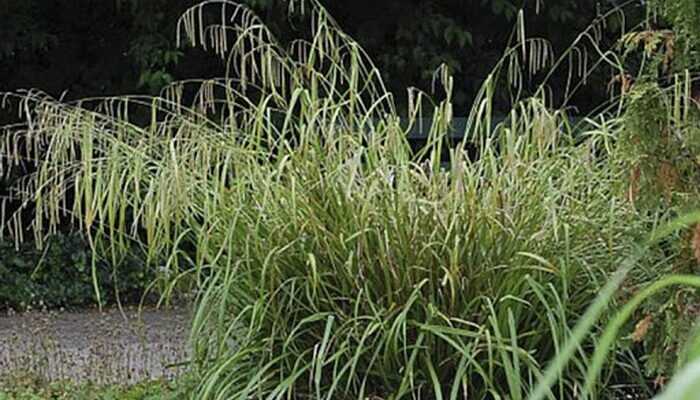
Kiwi is a greenish marsh color.
Drooping sedge
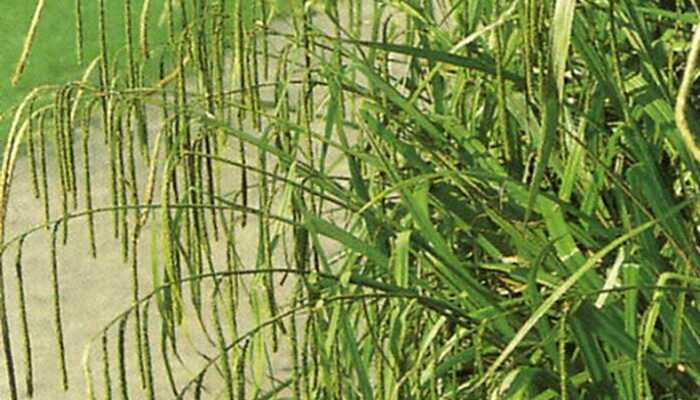
Hanging sedge, or large (Carex pendula or C. Maxima) – one of the largest dense sod sedges with a height of 70-150 cm.
Leaves are hard, overwintering, keeled, dark green above, glaucous below, up to 16 mm wide. Inflorescences above the leaves, spreading. Spikelets are thin, 5-8 in number, the upper one is male, the rest are female, sometimes with male flowers at the top, up to 15 cm long, hanging, green. The scales are dark, sharp. Pouches with a drawn two-toothed nose. Snout 3.
Plant of humid forests of Southern Europe, the Caucasus. Shade-tolerant, winter-hardy, loves moist fertile soil. May drop out after years of successful growth for some unknown reason, may need regular division.
Grades:

“Moonraker” – has unusually pale waxy leaves that appear in the spring, then turn green.
Plantain sedge
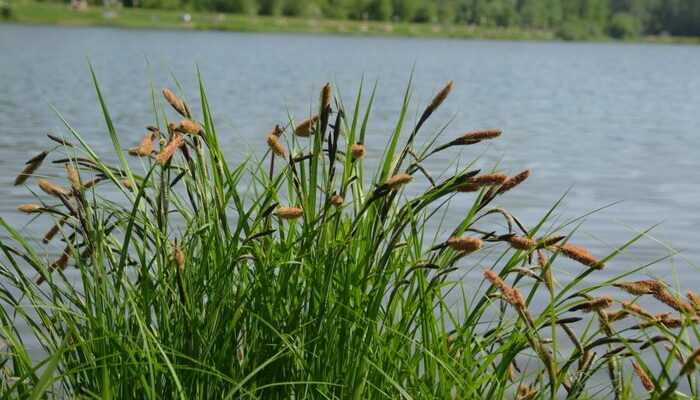
Plantain sedge, or broadleaf (Carex plantaginea, or C. Latifolia) is an evergreen perennial plant.
It spreads out, forming dense rugs of chaotically arranged leaves. The prominent leaves are purple at the base of the shoots. The leaves are dark or gray-green, up to 35 cm long, 1-3 cm wide, clearly bifold, the tops of old leaves are often withered. The stems are up to 50 cm high and bear 3-5 spikelets spaced apart. The upper spikelet is male, the rest are female, appressed, less often prostrate, loose, up to 3 cm long. The scales are keeled, sharp, with a green stripe. Oval pouches with a spout. Homeland – the forests of eastern North America. Shade-tolerant, burns in the sun. For fertile, moderately moist areas.
Ground cover plant. For shady gardens and flower beds.
Coastal sedge
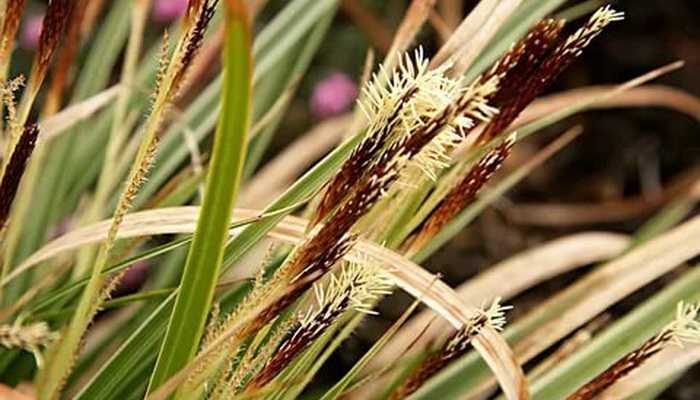
Coastal sedge, or coastal (Sageh riparia) forms loose, spreading turf.
Peduncles almost equal in height with leaves, about 120 cm. Leaves with a bluish tinge or bi-colored, 6-12 mm wide, flat. Several male spikelets, 3-6 cm long, greenish-brown. The sacs are dense, lanceolate, turning into a toothed spout. Scales with spiky, longer than sacs. Columns 3.
Grows in sedge bogs in Europe, southern Siberia, Central Asia. A graceful plant with curved leaves.
For wetlands and reservoirs. Needs restraint.
Grades:
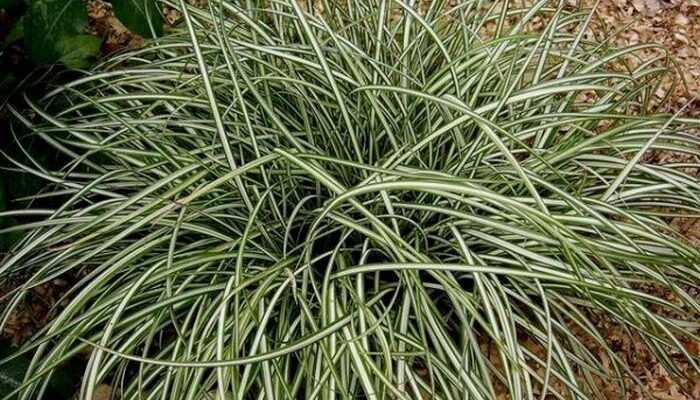
“Aigea” – with yellow leaves.
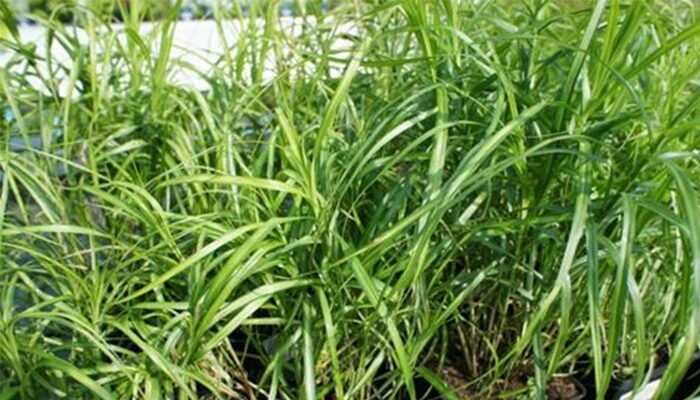
“Variegata” – bluish, graceful, with white shading, especially wide in the center of the leaf.
Poultry sedge
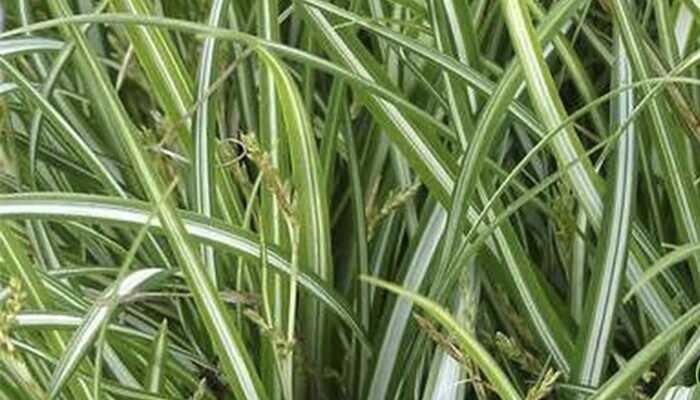
Bird-footed sedge (Carex ornithopoda) is generally similar to Fr. finger-like, but somewhat smaller.
The inflorescence is shorter, the spikelets in it are brought together in bunches. Occurs on dry grassy slopes and among shrubs, on limestones in Western Europe, except for the very south.
Grades:
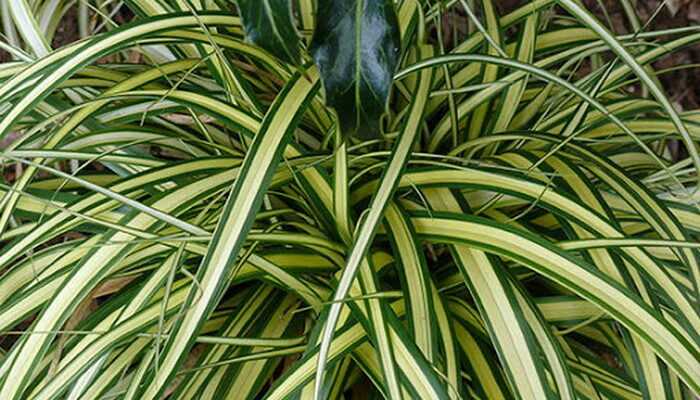
“Variegata” – up to 20 cm tall, leaf with a white stripe in the center.
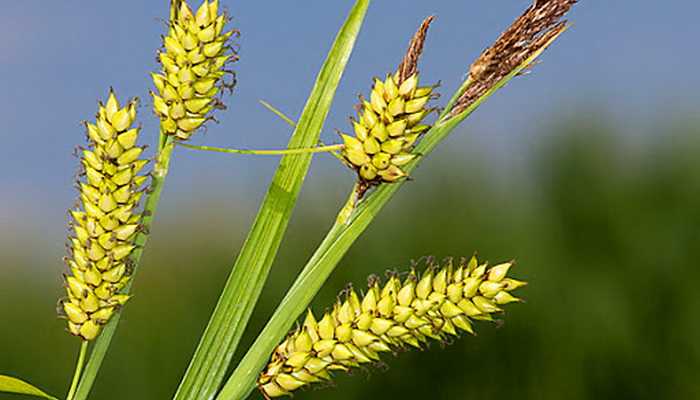
On sale sometimes confused with C. oshimensis “Evergold”.
Bladder sedge
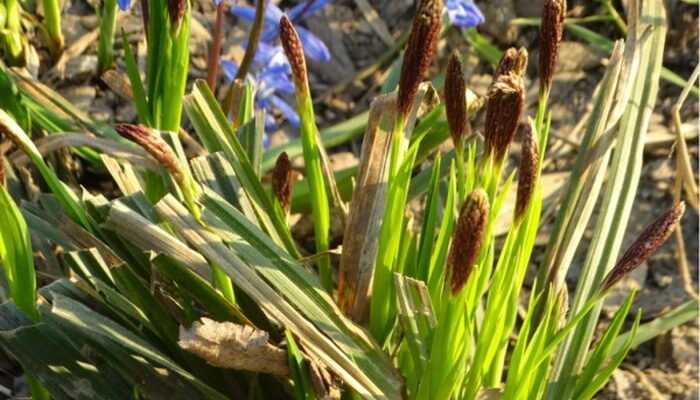
Bladder sedge (Carex vesicaria) spreads out with rhizomes, forming a dense, pure green curtain about 100 cm tall.
Leaves 3-8 mm wide. The stems do not exceed the leaves and bear 1-3 male spikelets and the same number of female ones. Female spikelets are spaced, drooping, up to 8 cm long and rather thick, at first light green, yellowing when ripe. The sacs are large, swollen, somewhat protruding, gradually narrowing into a two-toothed nose. Snout 3.
A common plant for all regions of Russia. It grows on the banks of water bodies, in swamps, in ditches. Can form frequent thickets.
Used to strengthen the banks of reservoirs.
Sedge cut
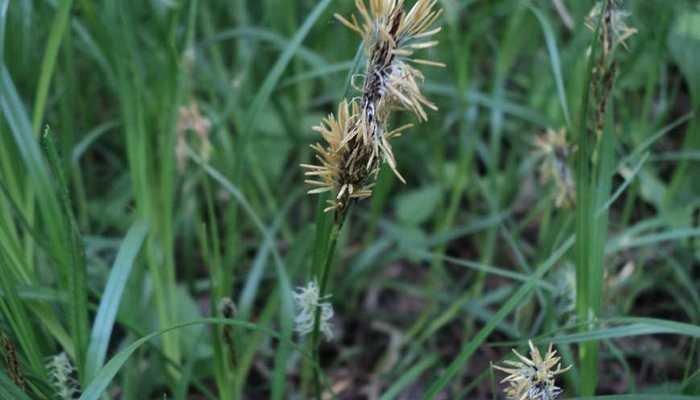
Cut sedge (Carex secta) forms a dense mound of spreading yellowish-green leaves in the form of a wig up to 80 cm high and 150 cm wide.
With age, it can rise above the soil level due to the gradual death of leaves in the lower part and the growth of the top. The leaves are grooved, keeled, 3-7 mm wide, almost the same length with peduncles – up to 100 cm. The inflorescence is loose, branched, with drooping spikelets. Spikelets are mixed, light brown, collected at the ends of lateral branches. The pouches are brown, winged, with a short, often two-toothed, spout. It differs from a similar species C. tenuiculmis in color, with wider leaves and longer and larger, strongly branched inflorescences. It is found in New Zealand, where it grows in open, damp meadows.
Recommended to grow in sunny, damp or well-watered areas.
Early sedge
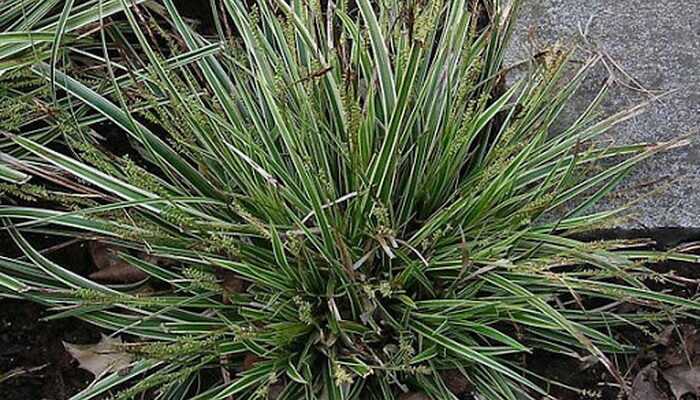
Early sedge (Carex paraesokh) forms dense, grayish-green clumps up to 20 cm high, spreading out with the help of a thick rhizome, which can lengthen by 40 cm per season.
Leaves are hard, protruding, 1,5-2 mm wide. Peduncles are longer than leaves, thin, with a compact brown inflorescence up to 2,5 cm long, consisting of several mixed spikelets. The pouches are flat-convex, with a wide winged spout. Knight 2.
Found in Europe, Central Asia, Western Siberia. Common plant in dry and low-grass meadows.
For creating alternative lawns in dry areas, slopes with light soil.
Spreading sedge
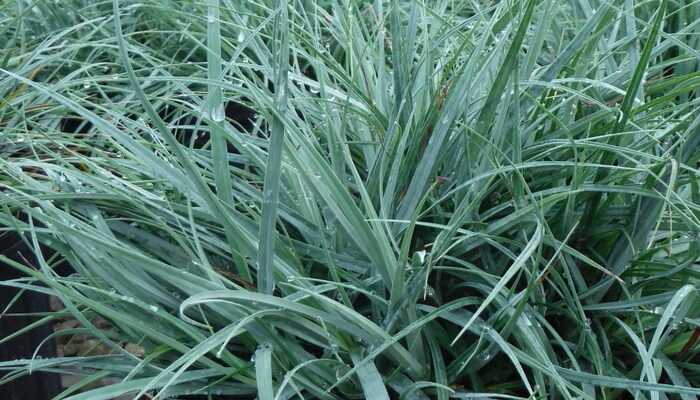
Spreading sedge (Carex laxiculmis) forms dense tufts up to 20 cm high.
Leaves are dark green or bluish, spreading, with pronounced lateral folds, up to 35 cm long and 1,5 cm wide. Stems are thin and spreading, longer than leaves, bearing 3-5 spikelets. There is only one male upper spikelet. The lower, female spikelets hang on long, up to 9 cm, hair-like legs and contain up to 10 flowers. The pouches are swollen, with short spouts, up to 4 mm long, colored in the color of the leaves. A North American plant that favors shade and moderate watering.
Good ground cover, growing slowly and firmly.
Grades:
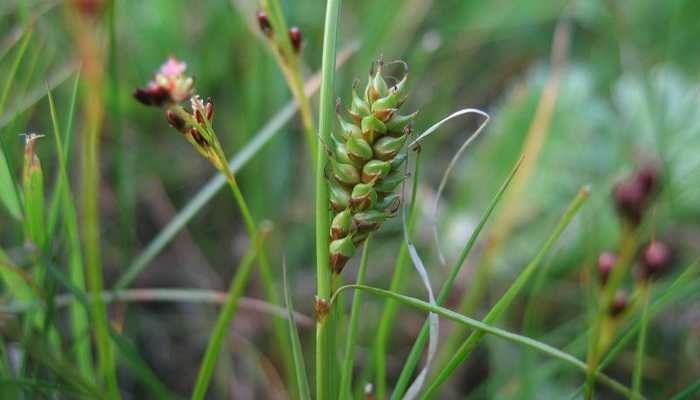
usually grown “Vippu Blue” (“Hobb”) – a form with extra wide leaves with a pronounced blue tinge.
Sedge arranged
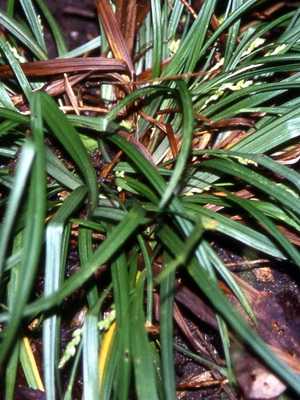
Arranged sedge (Carex remota) forms rather dense tufts of light green color.
Leaves are soft, up to 2 mm wide, shorter than the stem. Stems up to 60 cm tall, with small, spaced spikelets and their accompanying long
inflorescence leaves. Spikelets are mixed, ovoid, light green. The sacs are ovoid, gradually tapering into a spout. Knight 2.
It is found in the damp, shady forests of Europe and the Caucasus.
For shady gardens, stream decoration.
Rusty sedge
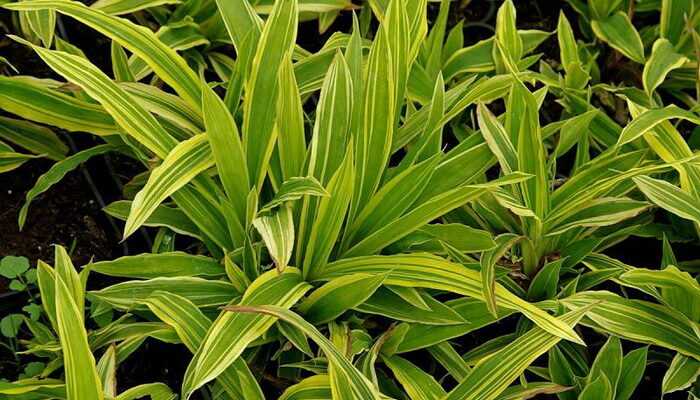
Rusty-spotted sedge (Sageh siderosticta) is a plant with long thin rhizomes, forming rugs up to 25 cm in height from broad-lanceolate leaves up to 3 cm in width.
The leaves are rather thin, dying off for the winter, with 3 distinct veins. Peduncles are not numerous, 10-40 cm long, with 4-8 mixed erect spikelets, with sparsely spaced flowers. The scales are dull, often with brown specks (for which the name is given). The pouches are oval, light green. Snout 3.
Grows in the forests of the Far East, China and Japan.
A groundcover for shady areas. The wild form is unpretentious and rather drought-resistant, but in the second half of summer, the leaves usually turn brown at the edges. Striped varieties tend to fall out in frosty winters.
Grades:
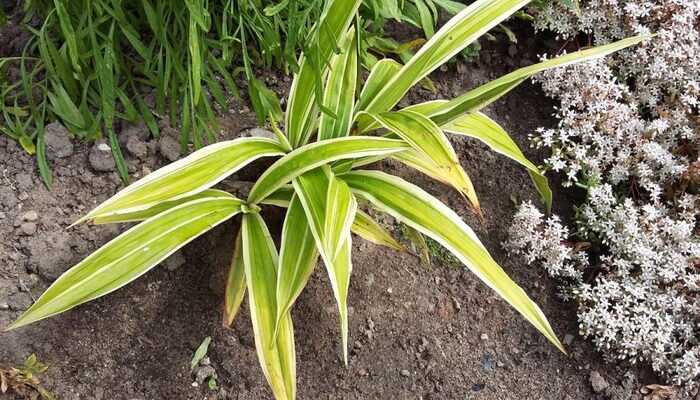
“Island Brokade” (C. ciliatomarginata “Shima Nishiki”) – the leaves are generously painted with cream and light yellow strokes of different widths.
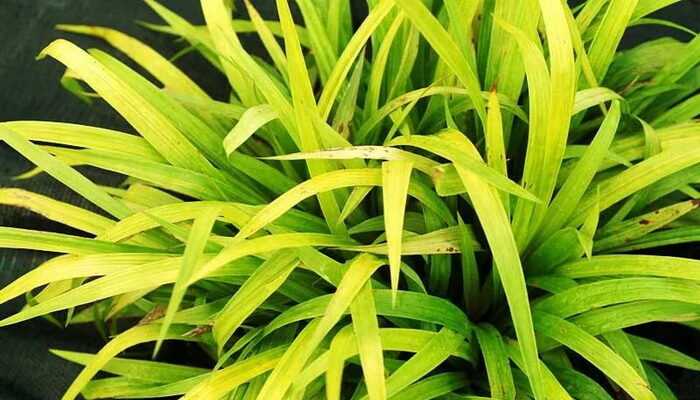
“Echigo Nishiki” (“Banana Boat”, “Golden Falls”) -Japanese variety with golden leaves bordered with green and with the same green strokes.
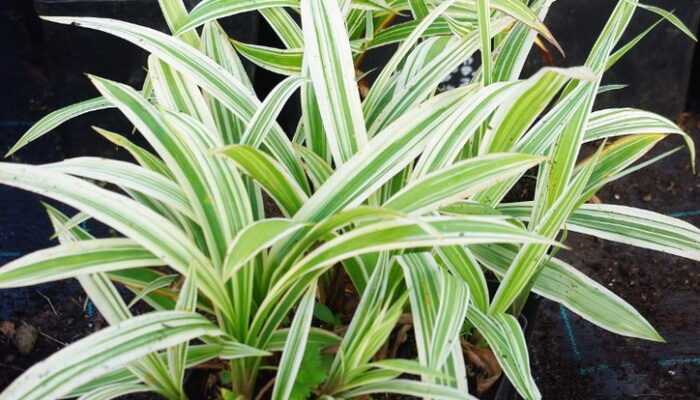
Lemon Zest and Old Barn stand out with lemon yellow leaves.
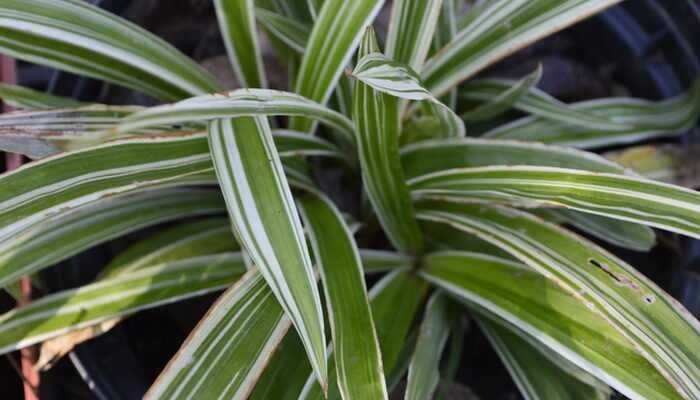
“Spring Snow” (“Kisokaido”) – creamy white leaves with a green edge, especially bright in spring, then turning green.
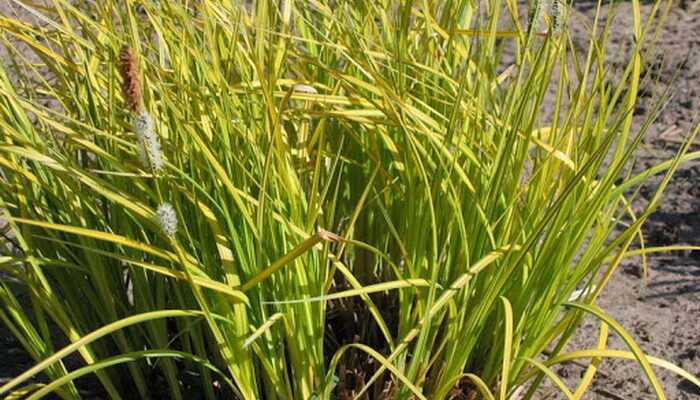
“Variegata” – white-bordered leaves with thin white strokes.
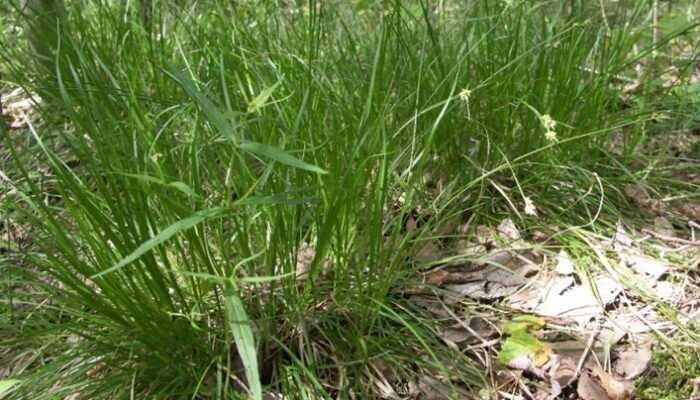
O. ciliate (C. ciliatomarginata) is a close species, and possibly just a variety of about. rusty-spotted, characterized by smaller leaves with cilia along the edges and pubescent sacs.
Neighboring sedge

Sedge adjacent, or spikelet (Carex contigua) forms dense tufts up to 60 cm in height.
Leaves 2-4 cm wide, green. Several mixed spikelets are clustered in a rather dense inflorescence. Male flowers are located at the top of the spikelet, female flowers are at the bottom. The scales are sharp, small. The sacs are ovoid, large, spread out, light brown in color, filled with loose tissue at the base. Spout gradually tapering, with 2 teeth. It is found in meadows, glades, in light forests, mainly in the European part of the country, as well as in Altai, the Caucasus and Western Europe.
Used for flower gardens in a natural style.
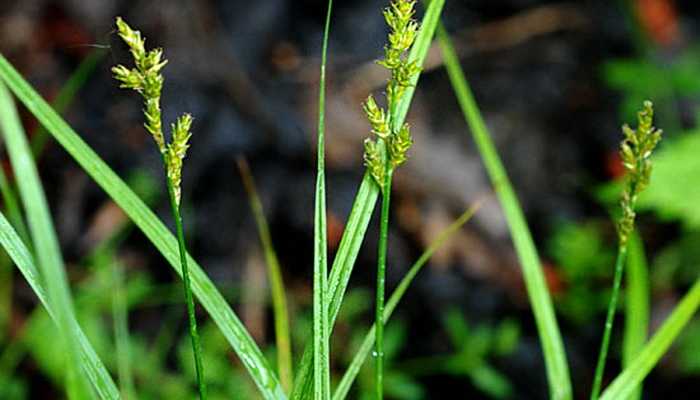
In the forests, a similar outwardly Fr. prickly (C. muricata).
Differs in the absence of spongy tissue in the bag. There are similar sedges in damp meadows and swamps: about. hedgehog (C. echinata) – less tall, with narrow leaves up to 2 mm wide, with greenish spikelets, in which female flowers sit higher than male ones.
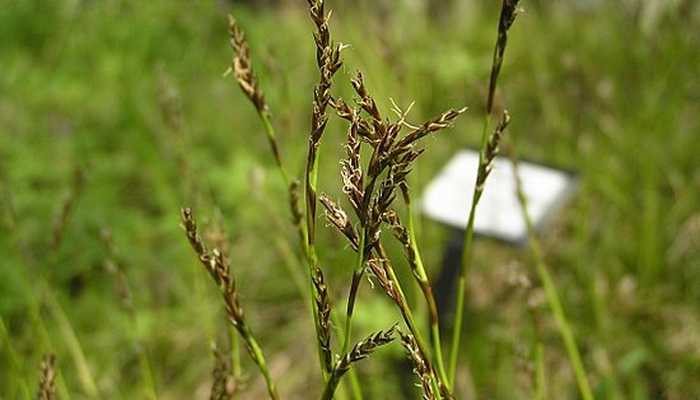
O. elongated (C. elongata) is a powerful plant, in the inflorescence there can be more than 10 rusty spikelets. The female flowers are also higher than the male ones.
Stop sedge
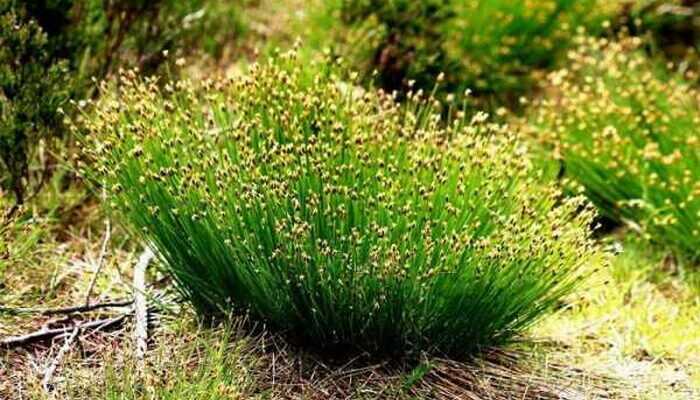
Foot sedge (Cage x pediformis) is a dense sod plant with short rhizomes and narrow, about 2 mm wide, often grayish leaves.
Stems are slightly longer than leaves, 20-40 cm long. It is characteristic that the staminate spikelet is usually small, up to 1 cm long, with few flowers and is often located on the same level with the upper pistillate spikelet or slightly below it. Sacs 2,5-3 mm long, pubescent, triangular. Covering scales are dark brown, with wide white-filmy edges. Snout 3.
Found throughout the country: often in the tundra, steppes and mountains in various habitats, usually dry and rocky.
For rock gardens, looks good in groups with dwarf conifers. It is very variable throughout its range, as the Siberian forest subspecies large-tailed (ssp. Macroura) with pure green leaves, forms relatively large and loose sods.
Sedge hard
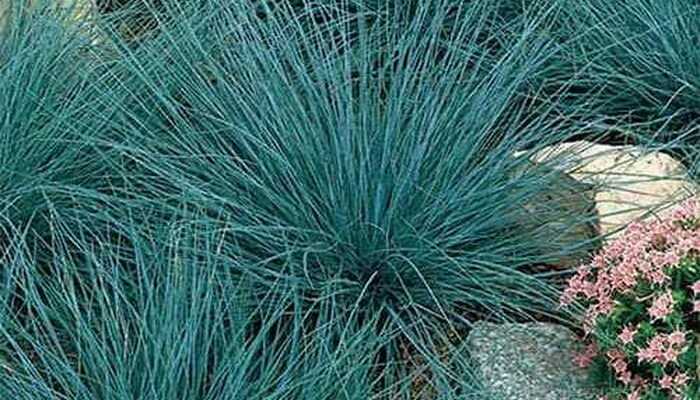
Sedge firm, or cushion (Carex firma) – a miniature plant similar to a cushion, one of the smallest sedges, 5-10 cm high.
The leaves are short, protruding, dark green, pointed. Spikelets are separate: one male, 2-3 female, sticking out. Pouches extended into a long nose. Snout 3.
Homeland – the mountains of Central Europe.
For rock gardens, sunny and shaded flower gardens.
Grades:
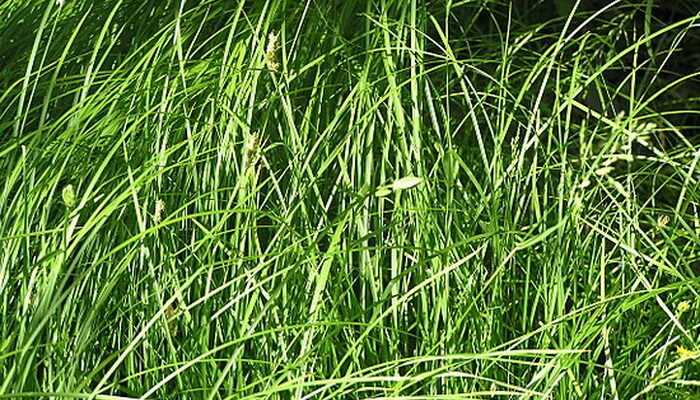
‘Variegata – leaves with creamy edges.
Shaggy sedge
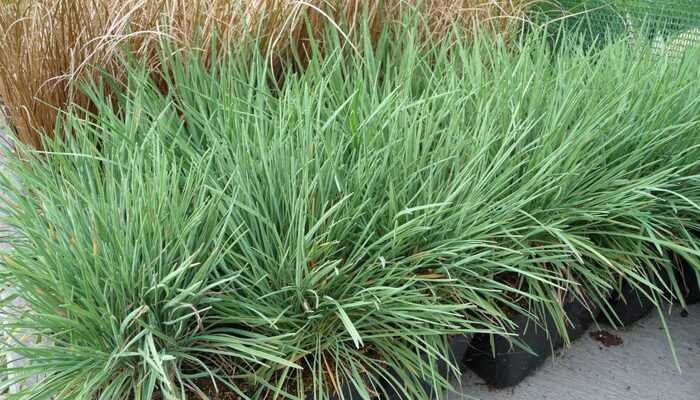
Shaggy sedge (Carex brizoides) quickly spreads with long branched rhizomes, forming a dense, bright green curtain.
Leaves are long drooping, thin, up to 2 mm wide, flat and soft. Few filamentous stems are shorter than leaves. It blooms rarely and poorly. Spikelets are mixed, small, greenish, closely packed. Membranous sacs, narrowed into a winged spout. Knight 2.
Found in the forests of Central Europe, including western Russia.
Very good for sodding semi-shaded and shady areas with light soil, for anchoring slopes. Creates a wavy cover. Keeps a fresh look until late autumn and does not require mowing.
Dull yellow sedge
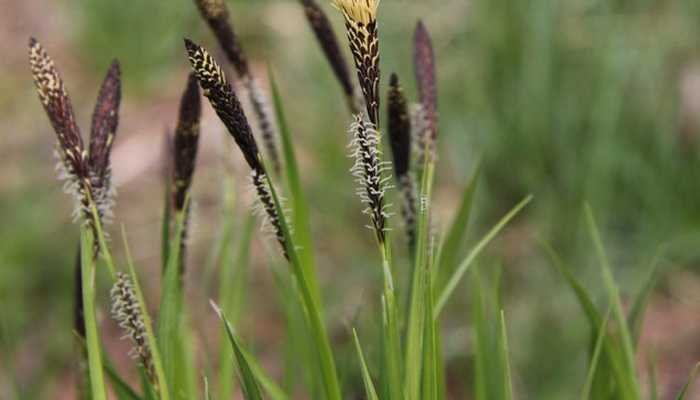
Dull yellow sedge (Sageh lurida) is a short-rhizome species that forms a rather dense clump. Stems are straight, up to 30 cm in height, densely leafy.
Leaves are pure green, flat or bifold, arcuate, more than 1 cm wide. The inflorescence is rather large, of crowded spikelets, the upper of which is male, the inflorescence is the same as the stem. Female spikelets, 3-4 in number, are oval, sometimes almost round, up to 2 cm thick. The sacs are 0,7-1 cm long, bright green, spread out, with distinct veins and a long, two-toothed nose. Snout 3.
A North American species found along the damp shores of water bodies and in damp forests. In culture, it can grow in conditions of moderate moisture, but at the same time does not achieve special power. It is notable for its large hedgehog inflorescences.
For coastal flower beds.
Black sedge
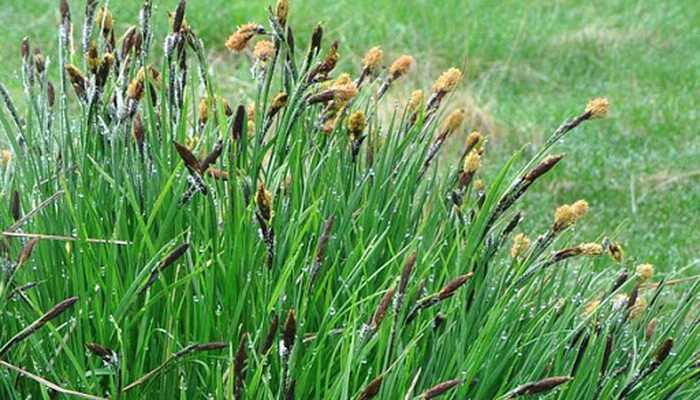
Black sedge (Sageh nigra) is a plant up to 50 cm tall, bluish, with short rhizomes.
Stem and leaves with rough cutting edges. The leaves are 1,5-4 mm wide, the lower inflorescence is shorter or equal to the inflorescence. It blooms in early spring, young female spikelets are black. Male spikelets 1, female – 2-4.
The scales are obtuse, the sedge is black, dark, with a narrow light stripe, shorter than the sacs. The sacs are ovoid, with noticeable veins, flat-convex. Rylets 2. Distributed in central Russia, Western Siberia and Western Europe. Grows in forests, damp meadows and the shores of water bodies.
An excellent plant for strengthening the banks.
Grades:
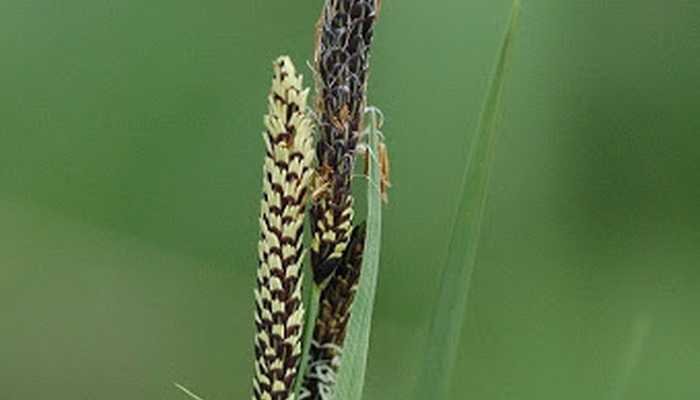
“Variegata” (“On line”) – leaves with narrow white (cream) edges and strokes.
Blackish sedge
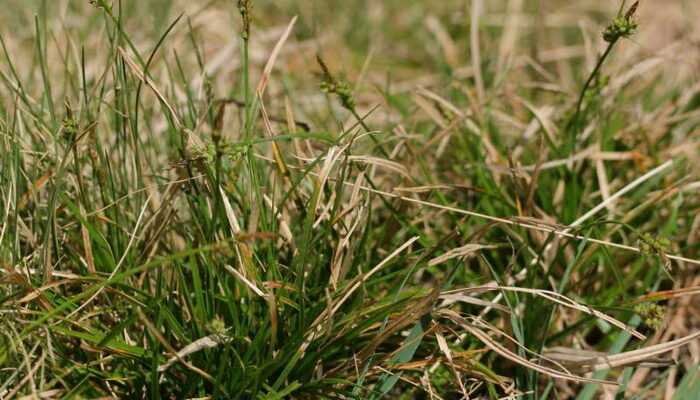
Blackish or blackened sedge (Carex atrata) forms a dense green turf.
Flowering stems up to 40 cm tall, leaves are half as long. Leaf width 3-5 mm. One male spikelet. Females are dense, ovate, 1–2 cm long, brownish black, raised on slender legs. The sacs are light, elliptical, flattened, without veins, with a short nose. Snout 3.
It is found in damp and swampy places, rocky slopes in the tundra, in the alpine and subalpine belts of the mountains of Central Europe and North America.
A beautiful and neat plant for flower gardens and rock gardens.
In the same places, a similar species is found – about. black-brown (C. atrofusca) with gray leaves, hanging spikelets and completely black sacs.
Ball-bearing sedge

Ball-bearing sedge (Carex pilulifera) forms dense tussocks. Stems up to 40 cm tall. Leaves are about half as long, 2-2,5 mm wide, flat.
Spikelets are crowded, one male, 2-4 female, roundish dense, up to 1 cm long. The scales are wide, brown, with a point. The pouches are shortly pubescent, almost without a spout. Rylets 3. Occurs in Europe, including its Russian part, in dry meadows, in pine forests on the sand.
A neat drought-resistant plant for rock gardens and sunny flower beds.
Grades:
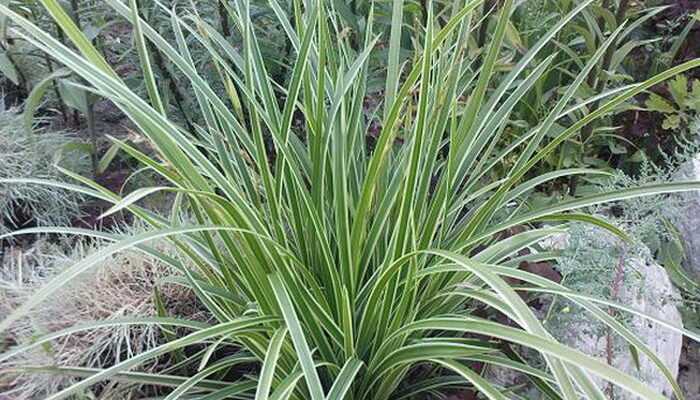
English cultivar “Tinney’s Princess” is decorated with creamy white shading in the center of the leaf.
Testicular sedge
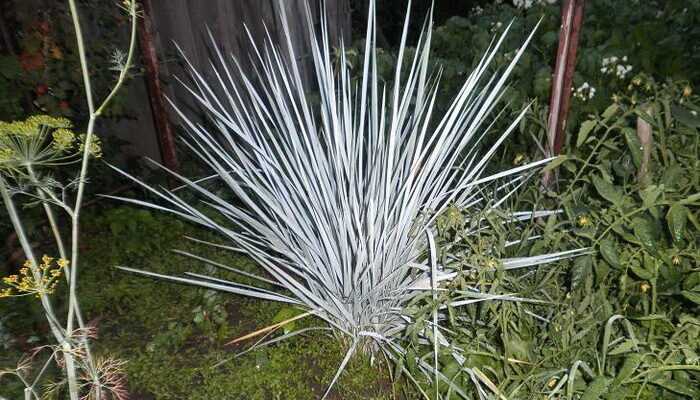
Testicular sedge (Carex testacea) is commercially named Orange sedge. It is a dense sod plant up to 60 (80) cm tall.
The leaves are olive green with a strong dark or orange-red tint, 1-2,5 mm wide, grooved. Peduncles are very thin, elongate greatly when the seeds ripen and fall off. Spikelets 3-5, contiguous, the terminal spikelet is male, the rest are female, sessile. The scales are brown, spinous. The sacs are oval, shiny, with distinct veins, sharply narrowed into a two-toothed nose. Knight 2.
In Russia, only in the middle zone there are about 70 species of wild sedges. They inhabit swamps, forests, sandy wastelands, border the shores of reservoirs. Only at first glance they seem monotonous. But one has only to take a closer look, as many of their forms, colors, biological characteristics will manifest themselves. And although sedges are not those plants that attract attention in nature, if they are successfully placed in a flower garden, they may well become its decoration.
From the closely related Fr. lash-forming is distinguished by a bright reddish shade of leaves and lighter and thinner scales with shading. Found in New Zealand on coastal sands, grasslands and forests. Grows well in sun and shade, may get wet, unstable.
Grades:
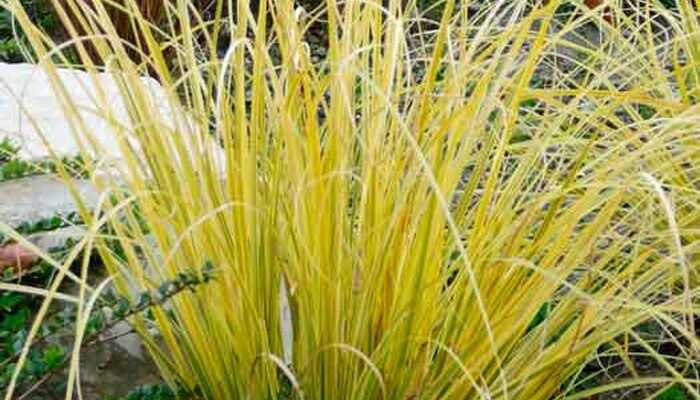
‘Prairie Fire’ – a variety with a particularly bright color.
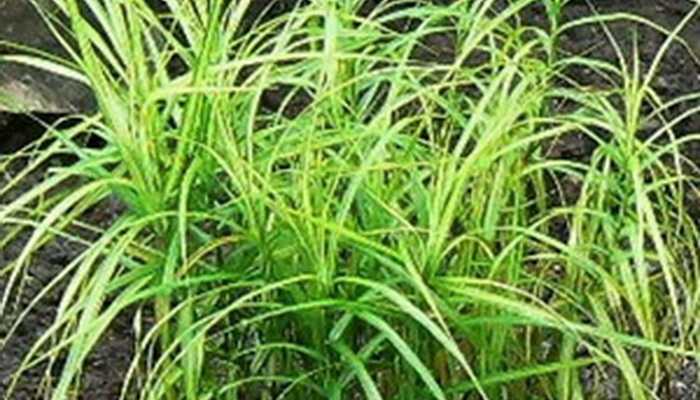
‘Old Gold’ – green with bronze and orange tints, golden after frost
Nurseries offer a number of other New Zealand sedges:
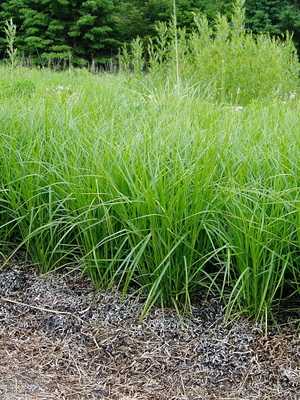
nap (C. dipsacea)

kaloides (C. kaloides)
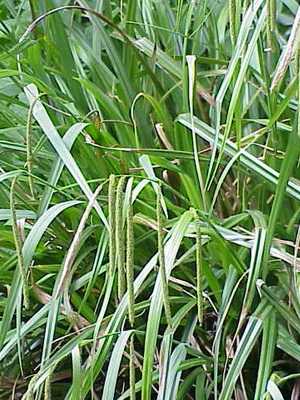
Maori (C. maorica)
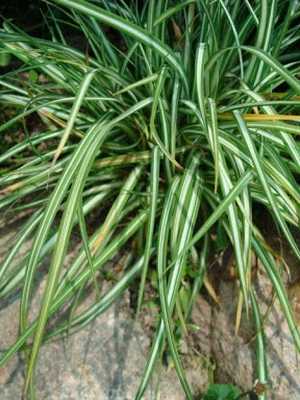
sparse (S. dissita)
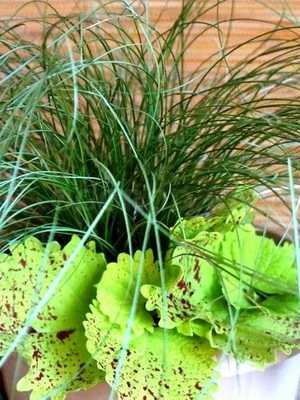
thin straw (C. tenuiculmis)

tripartite (C. trifida)
All of them are just as unreliable in the middle lane; it is more promising to grow them as annuals.


